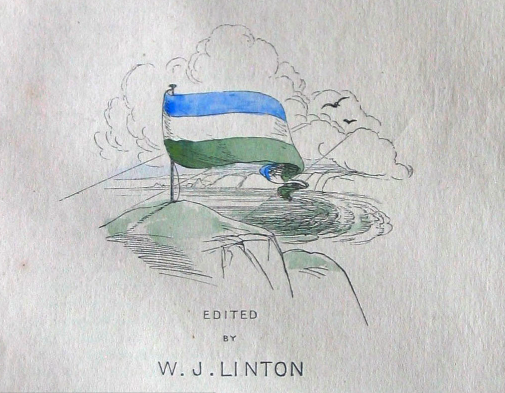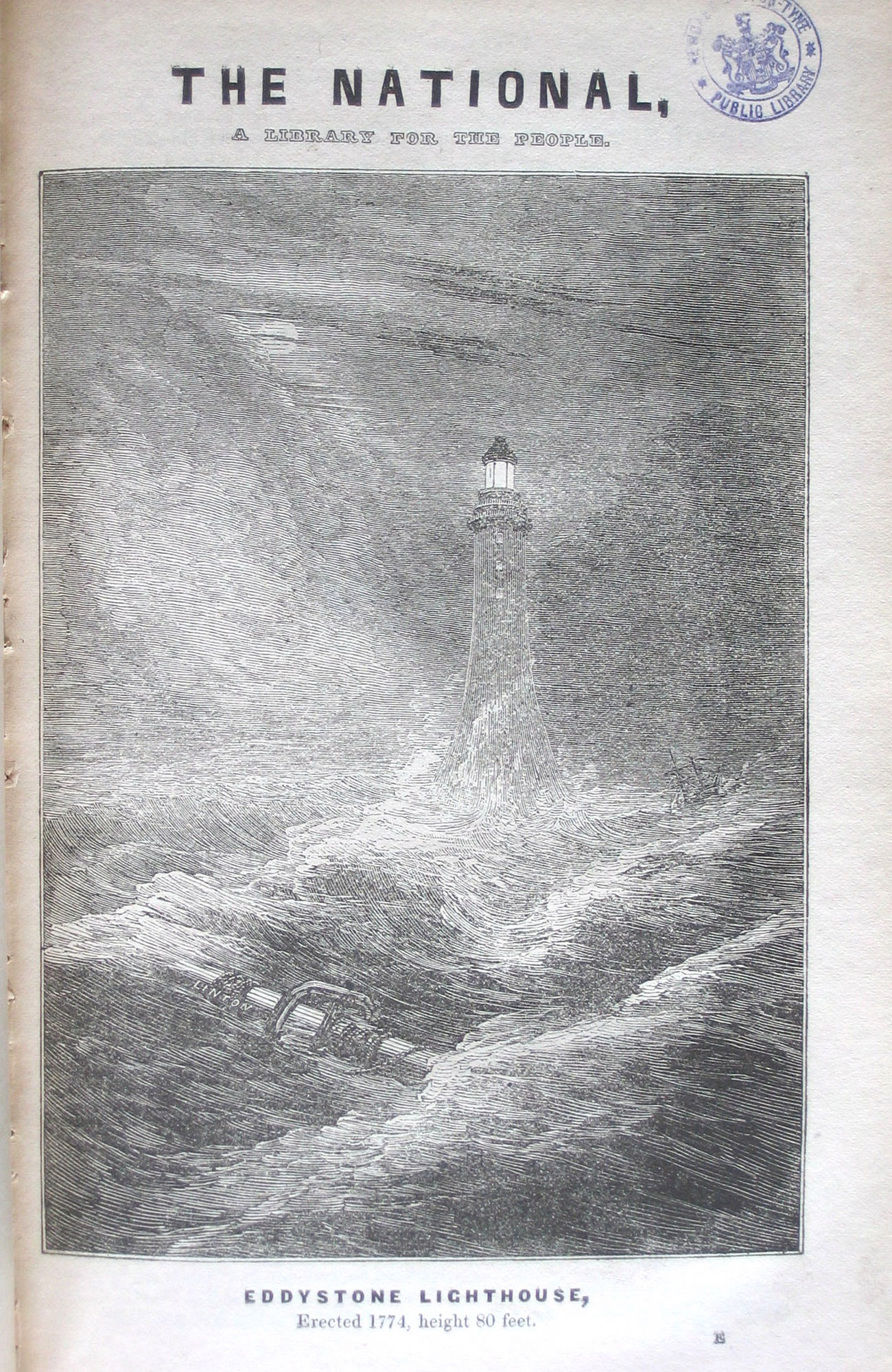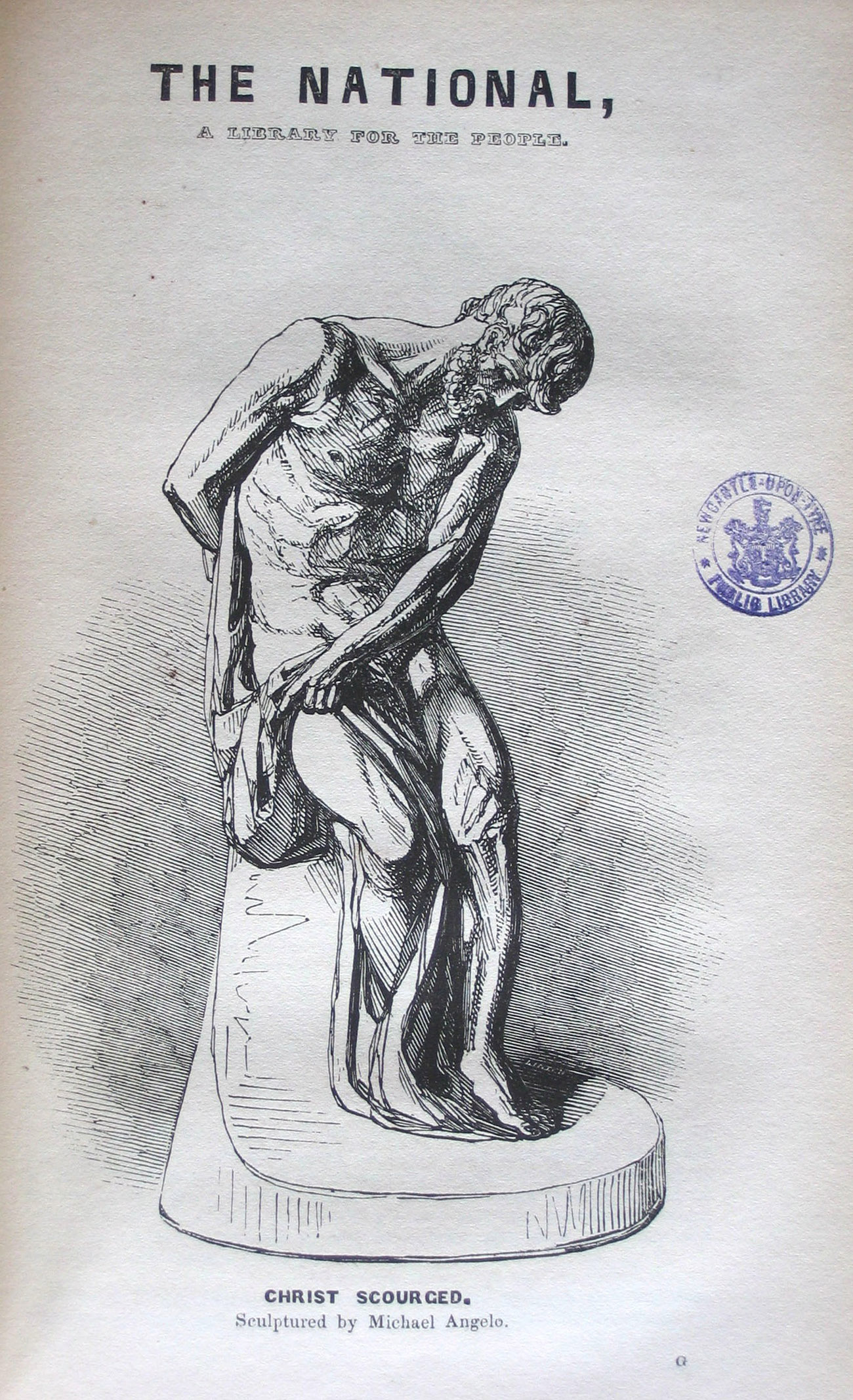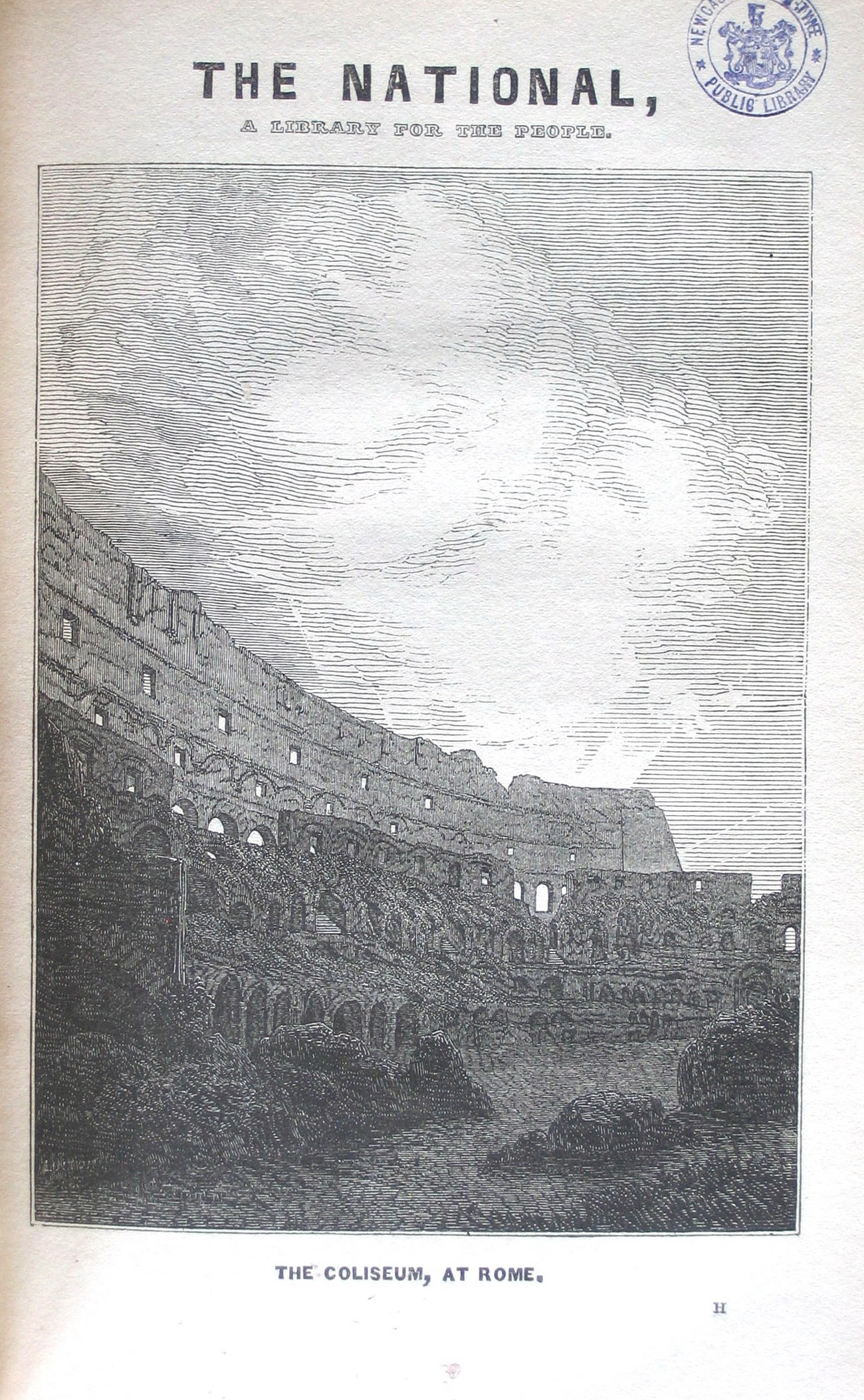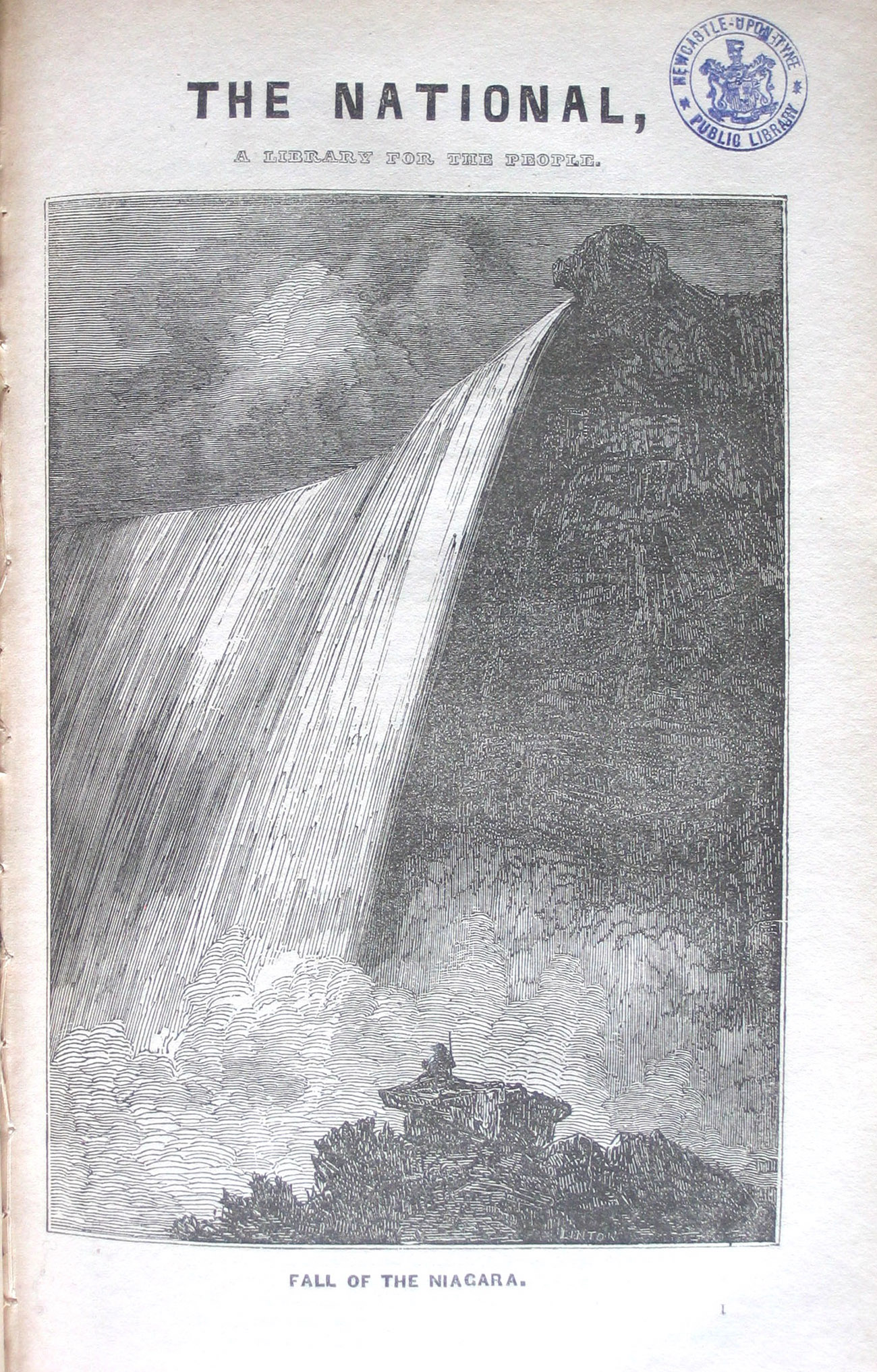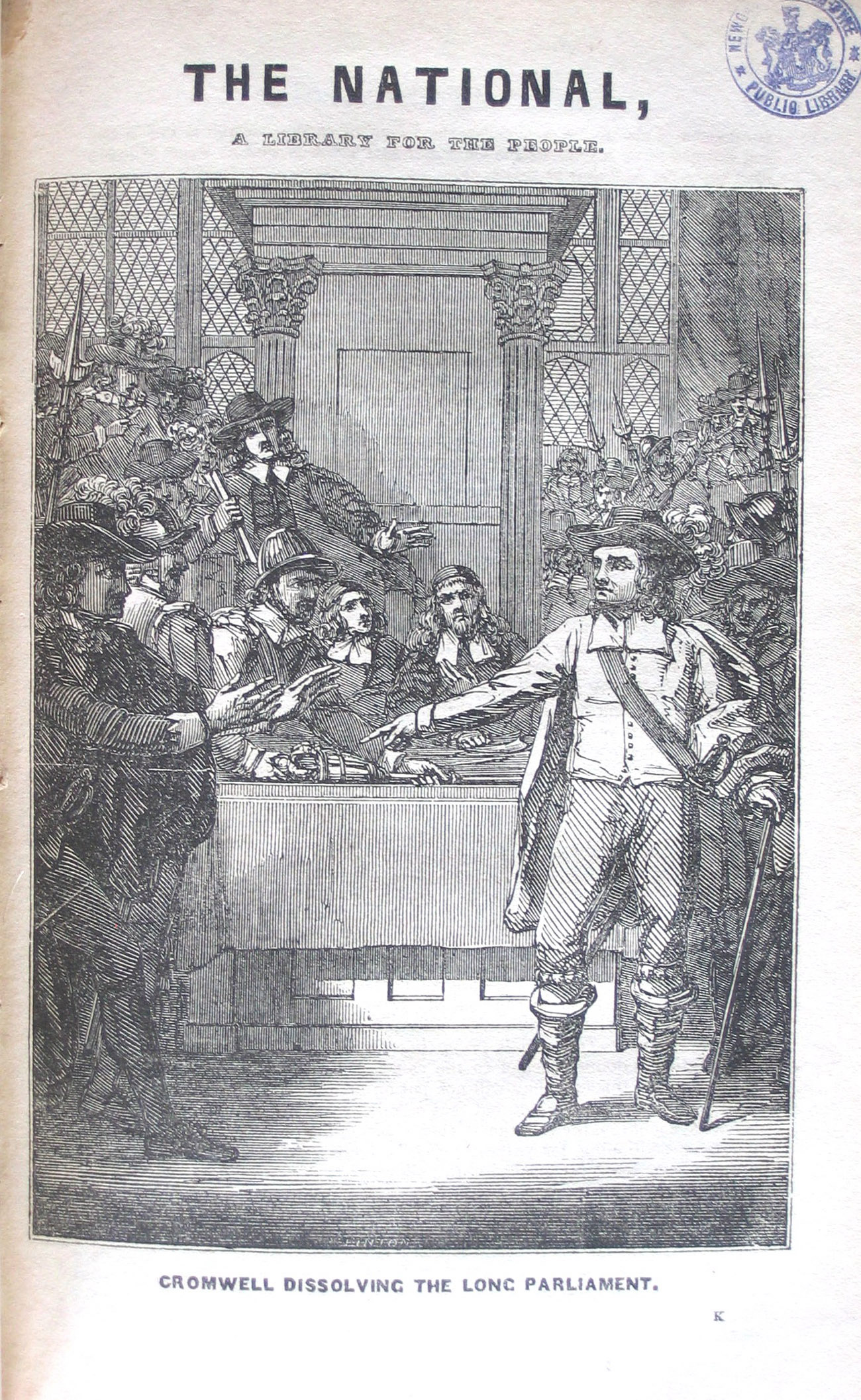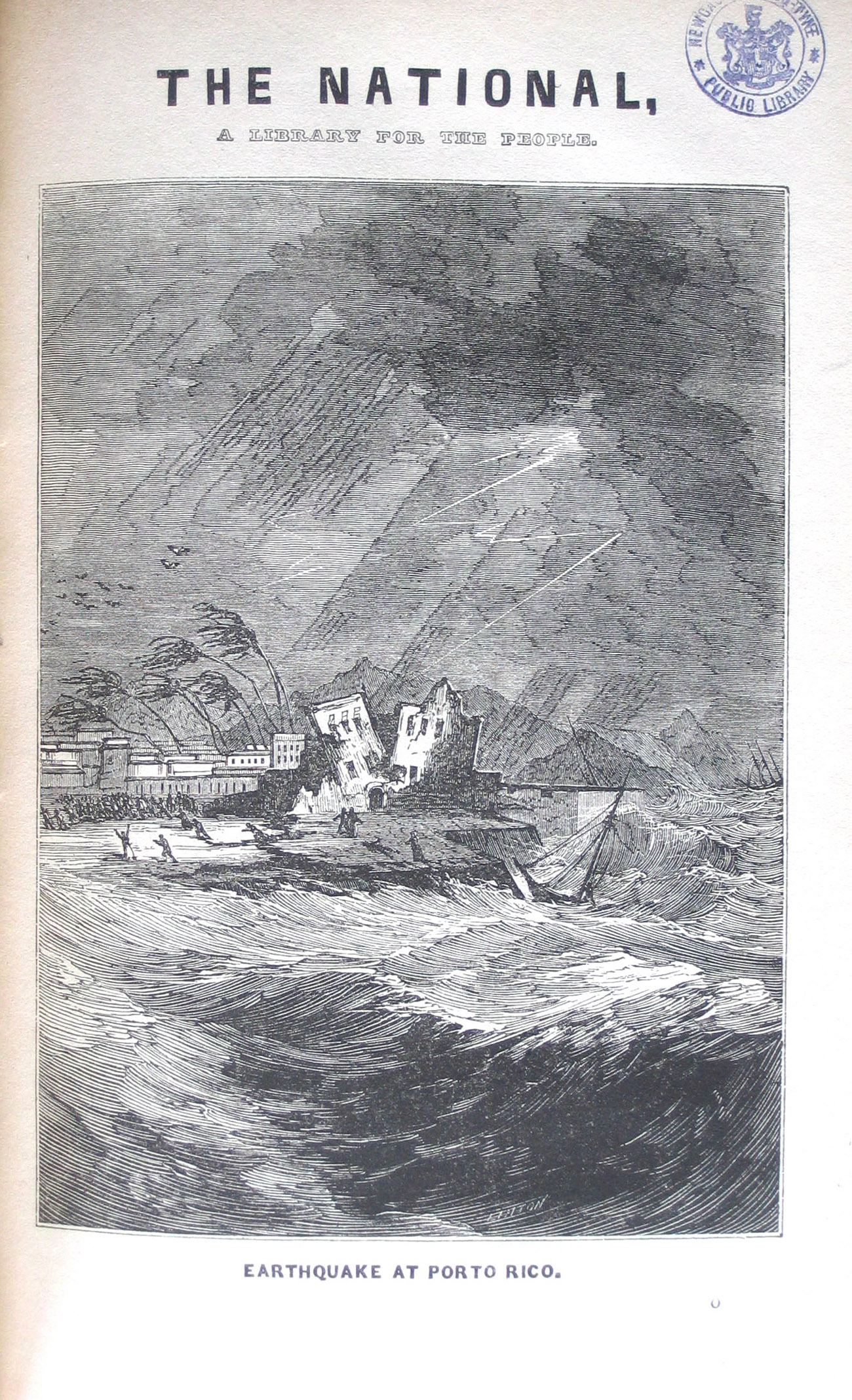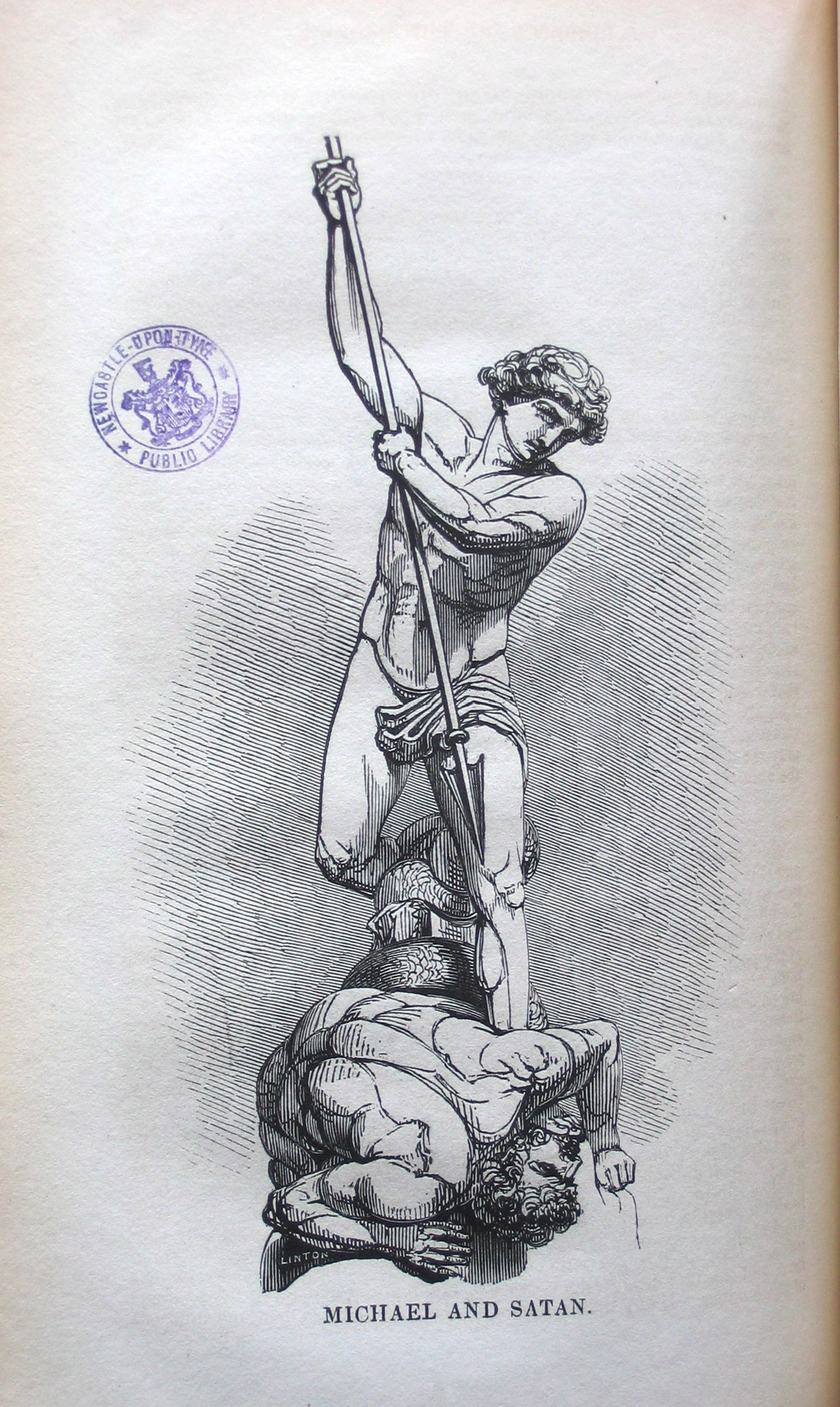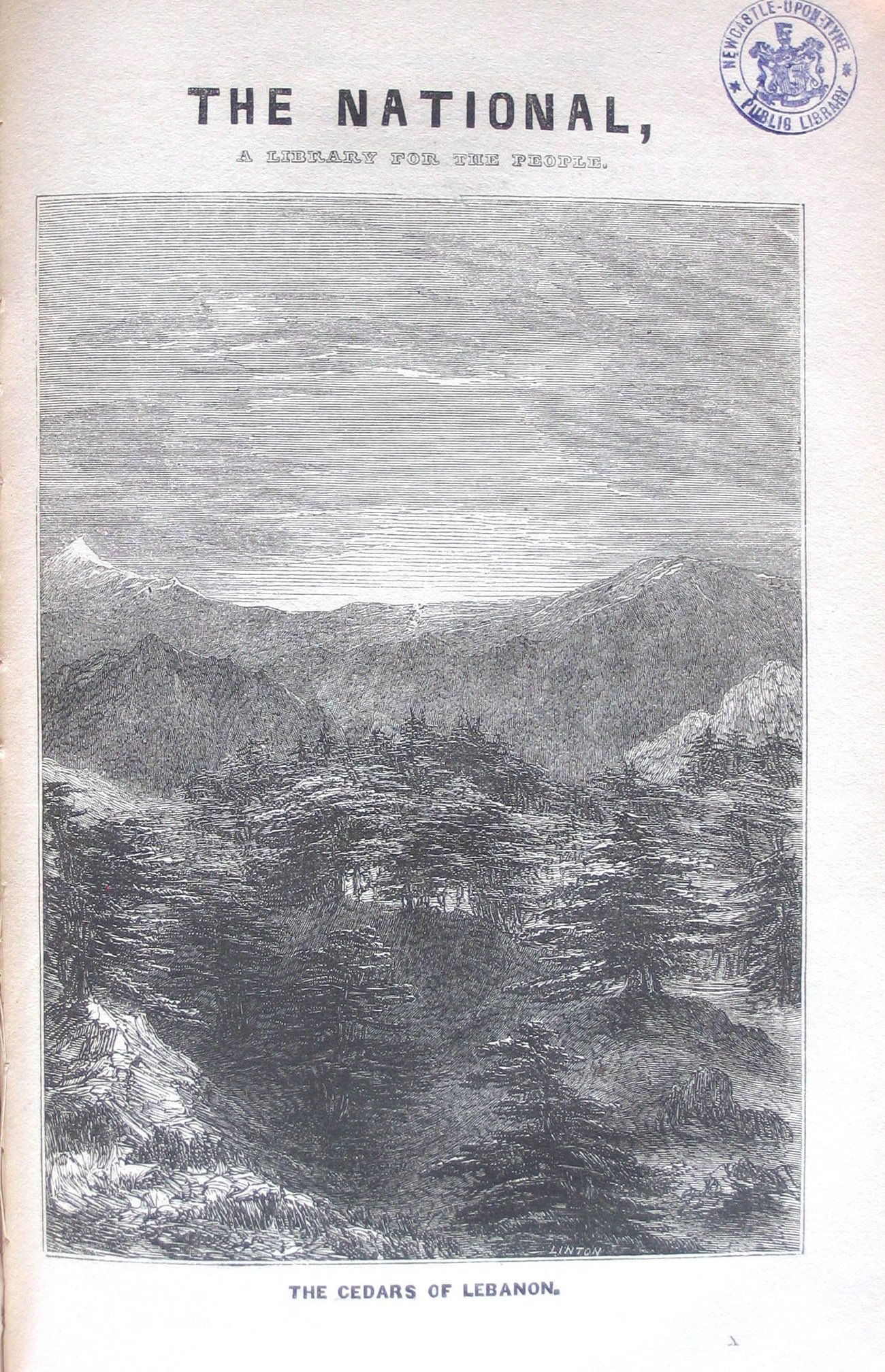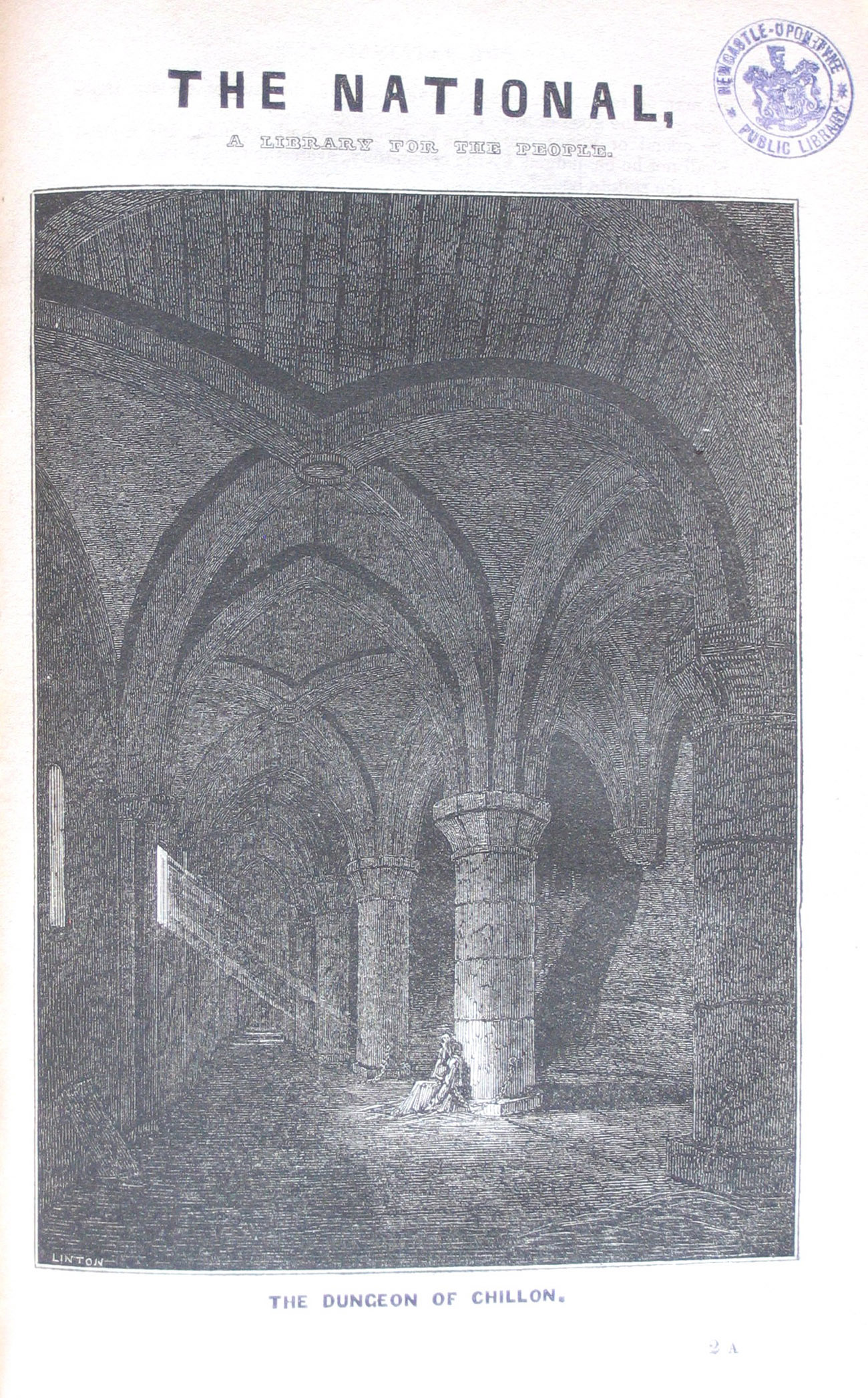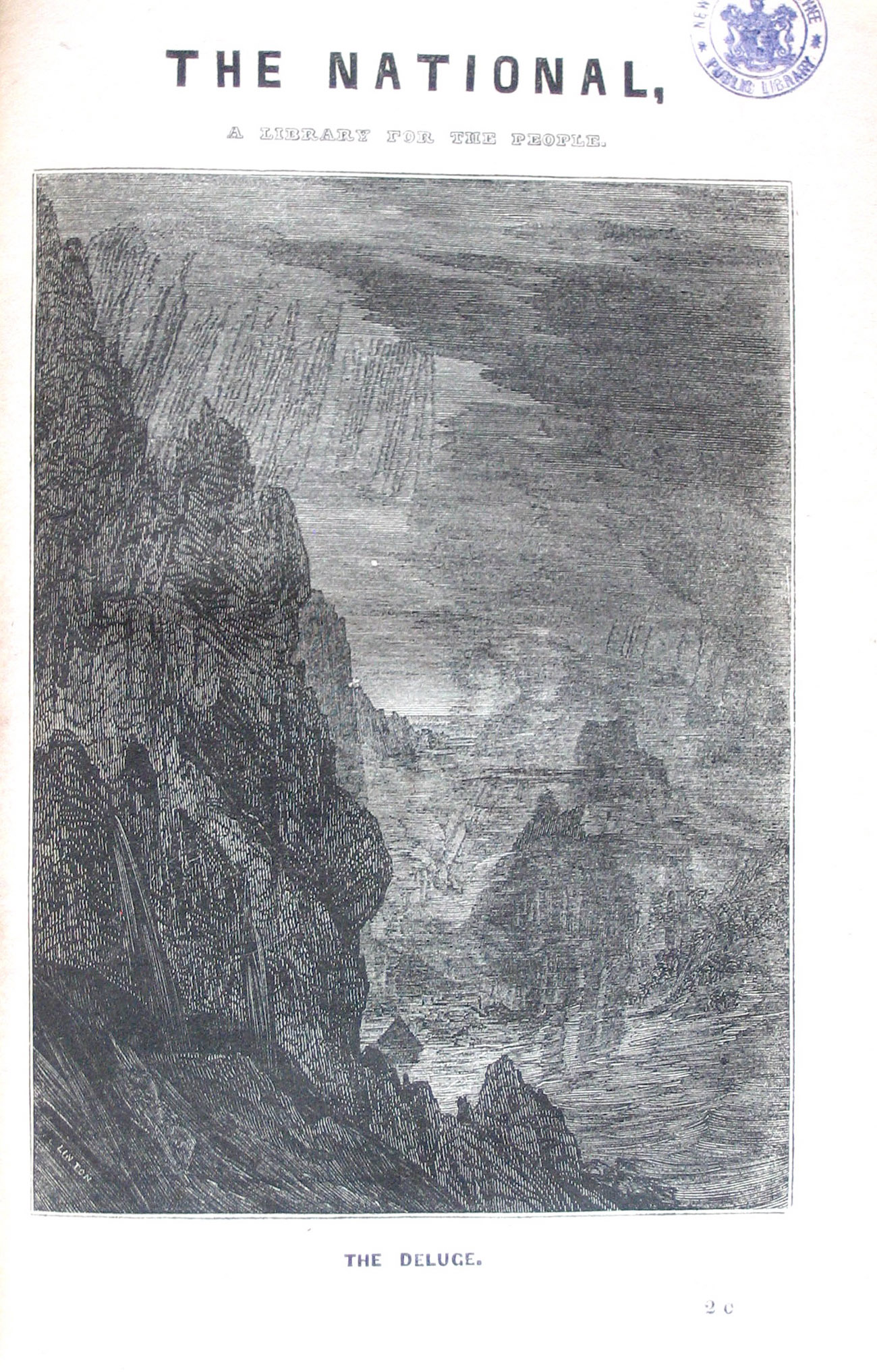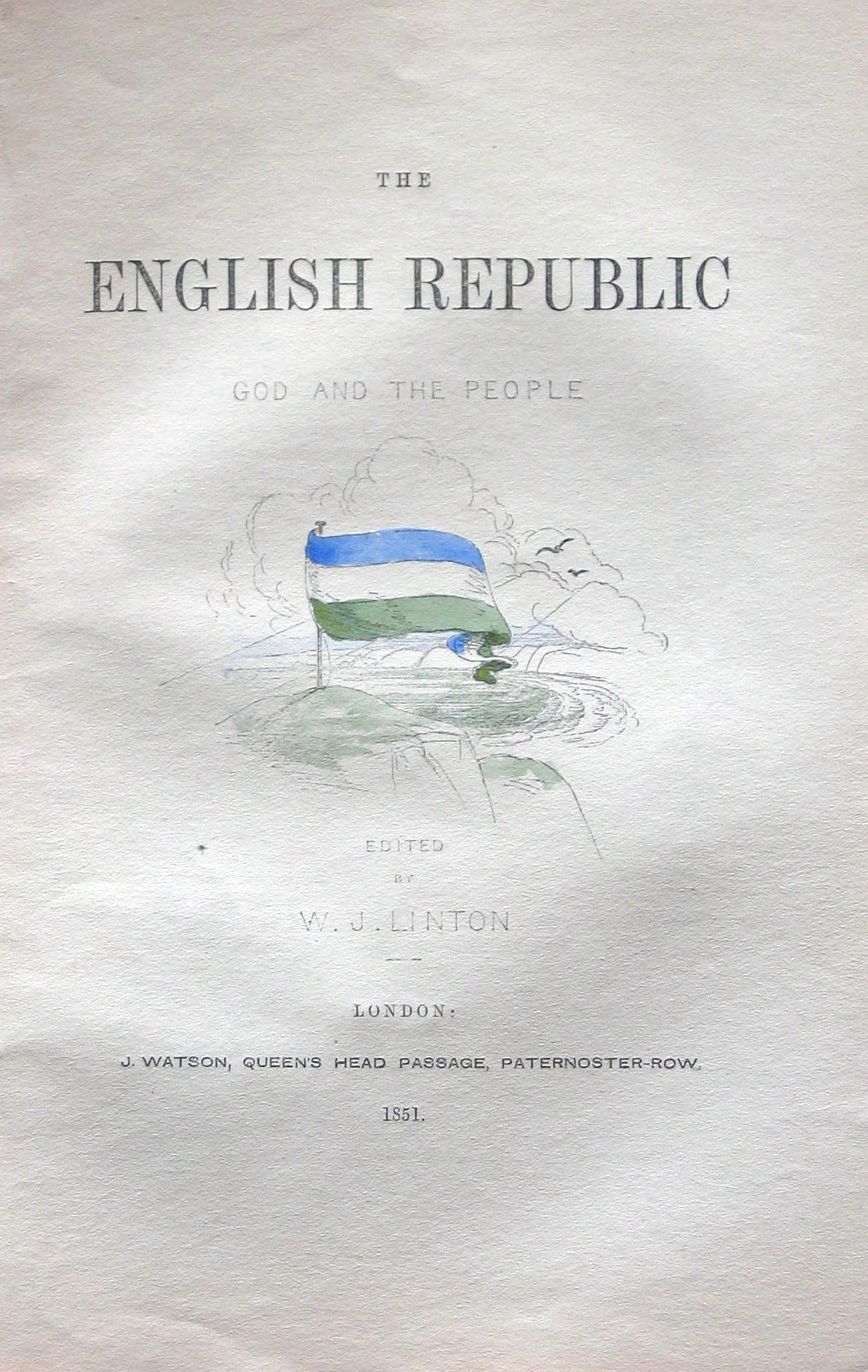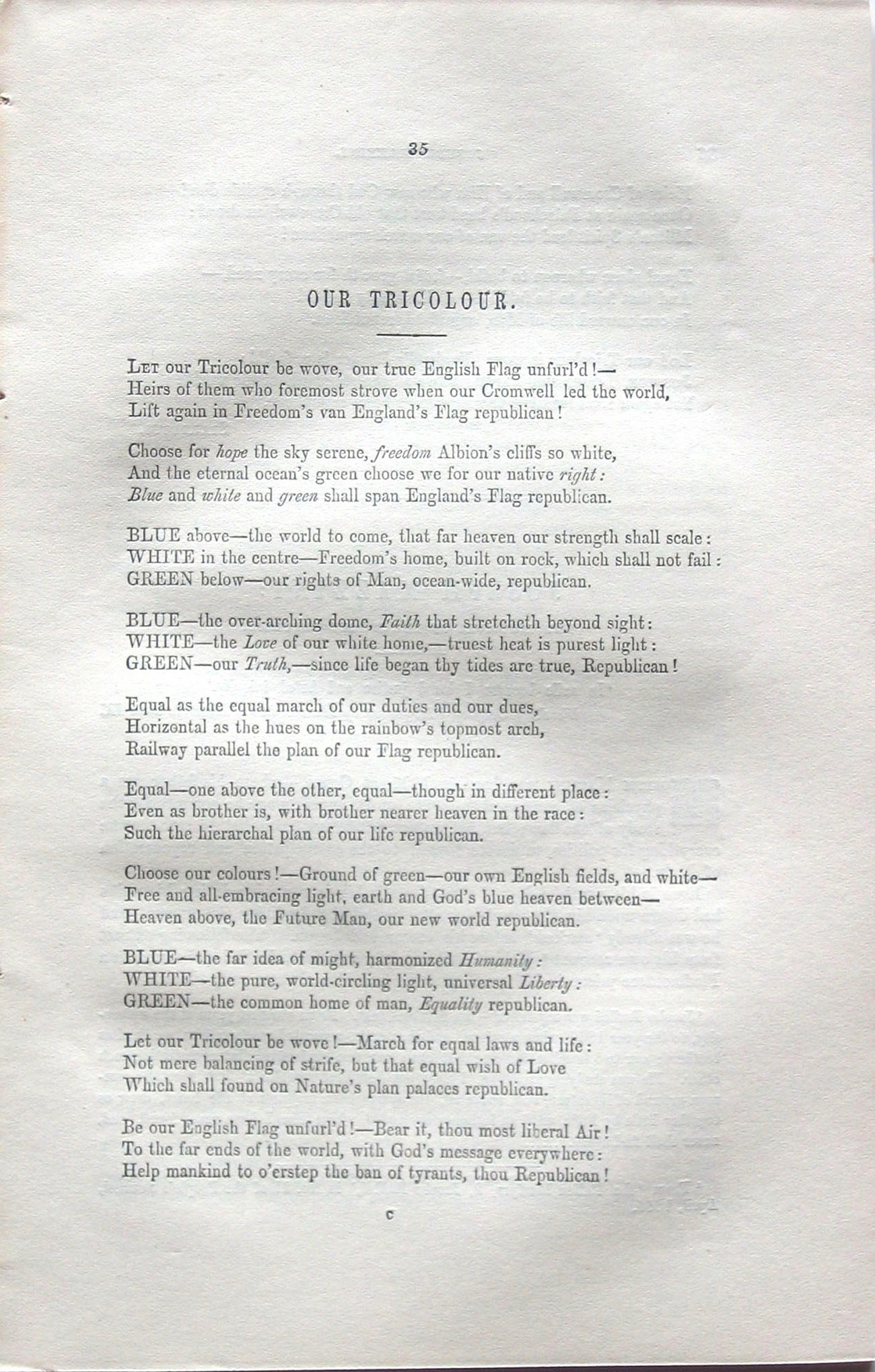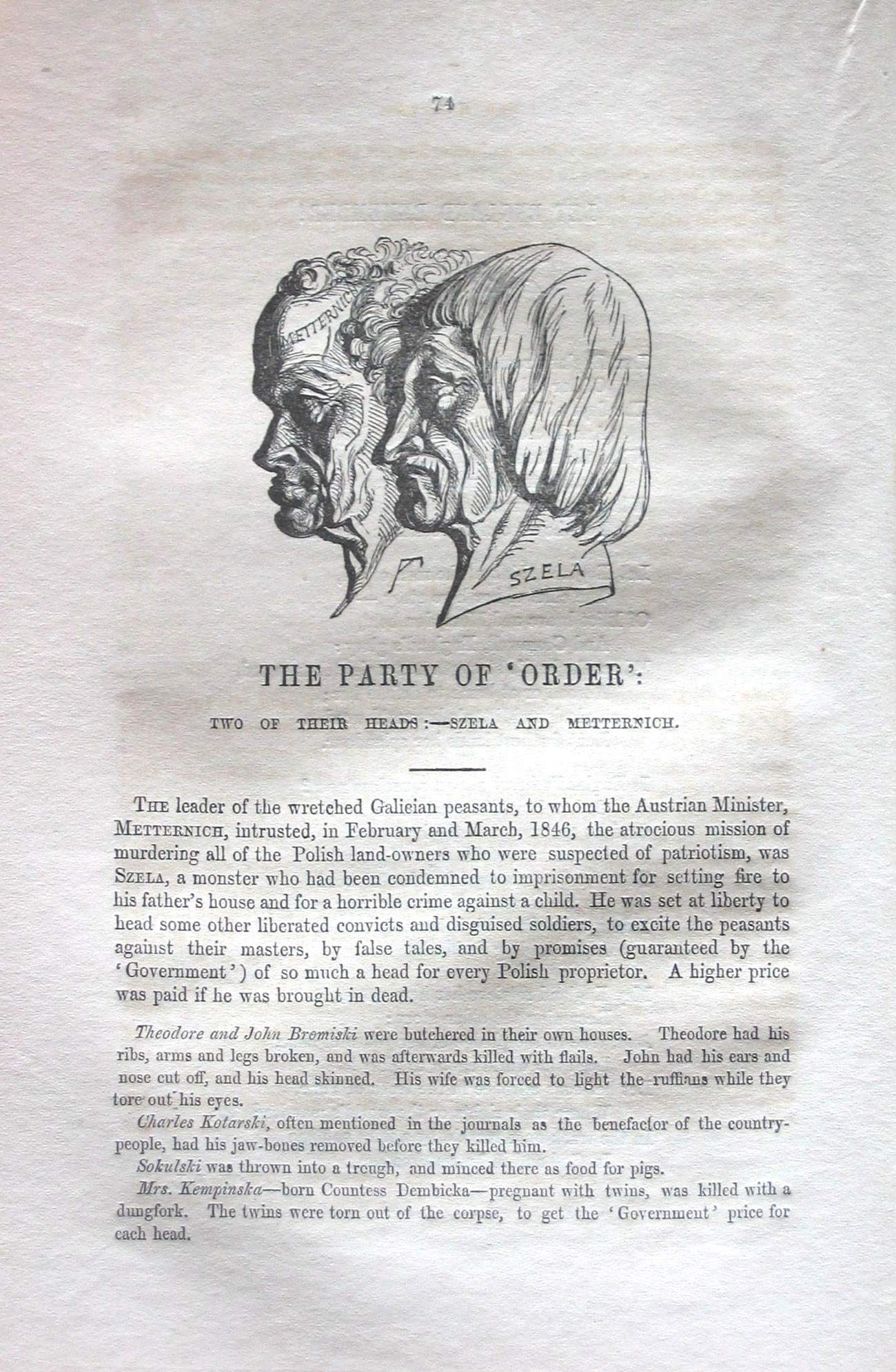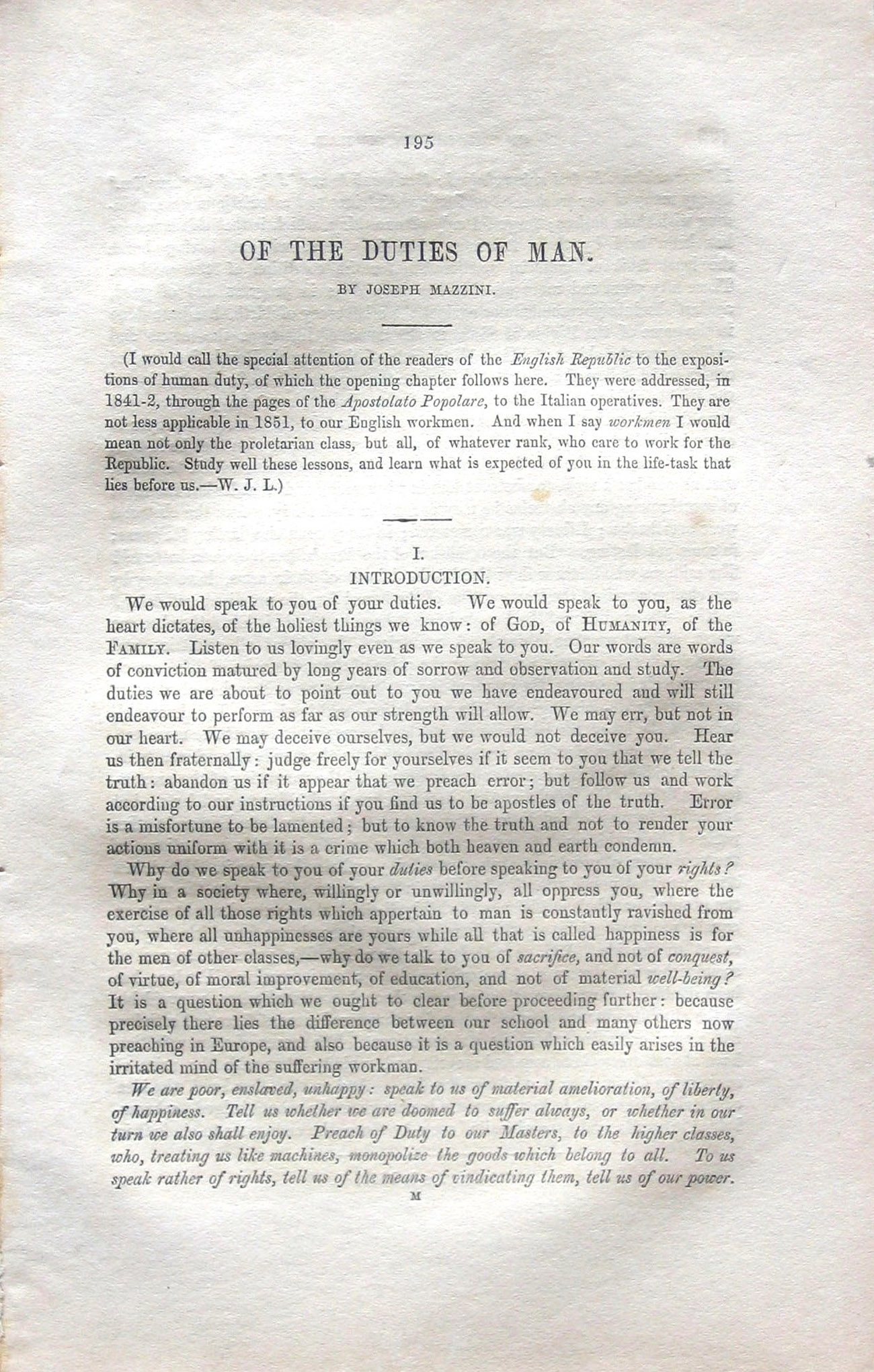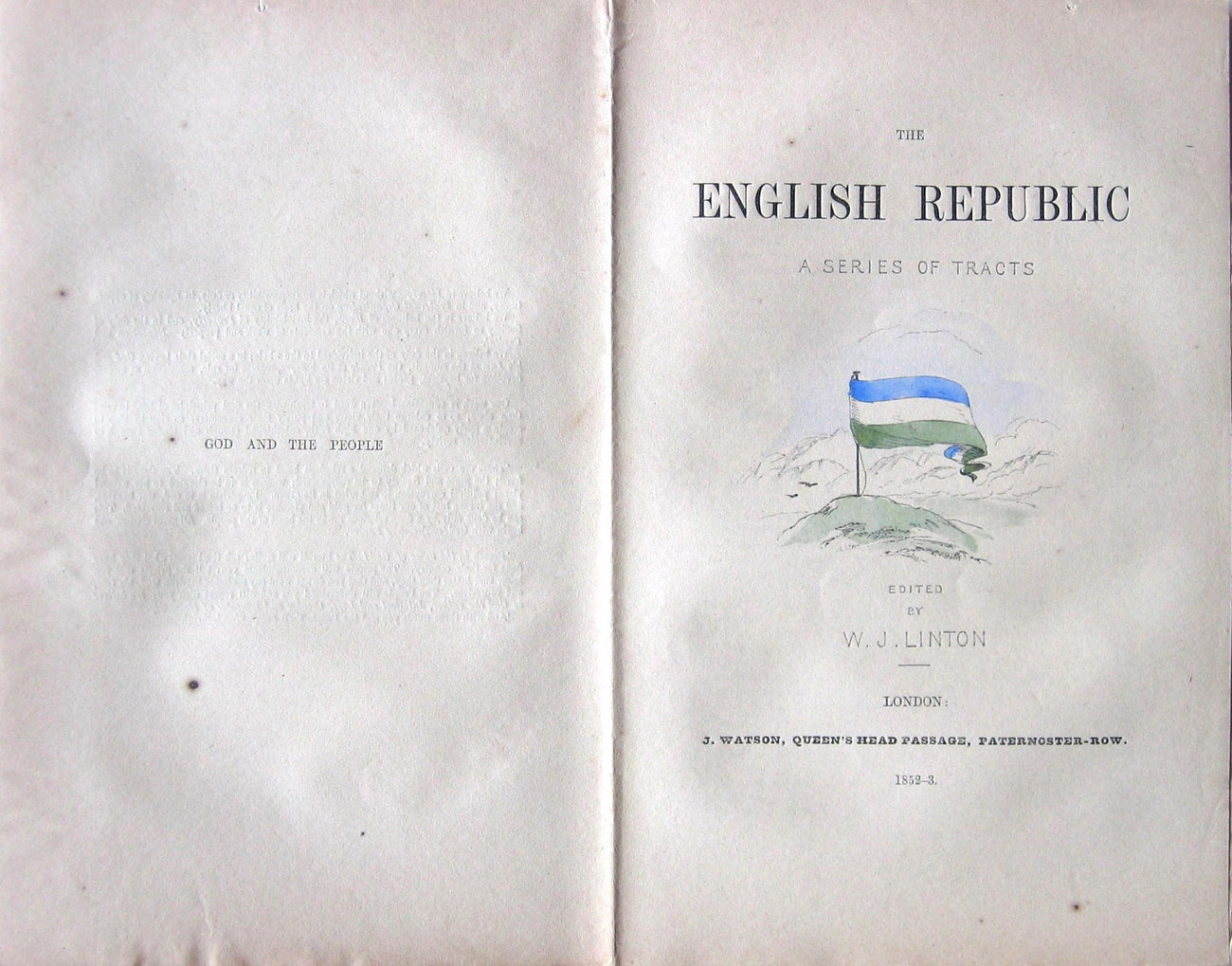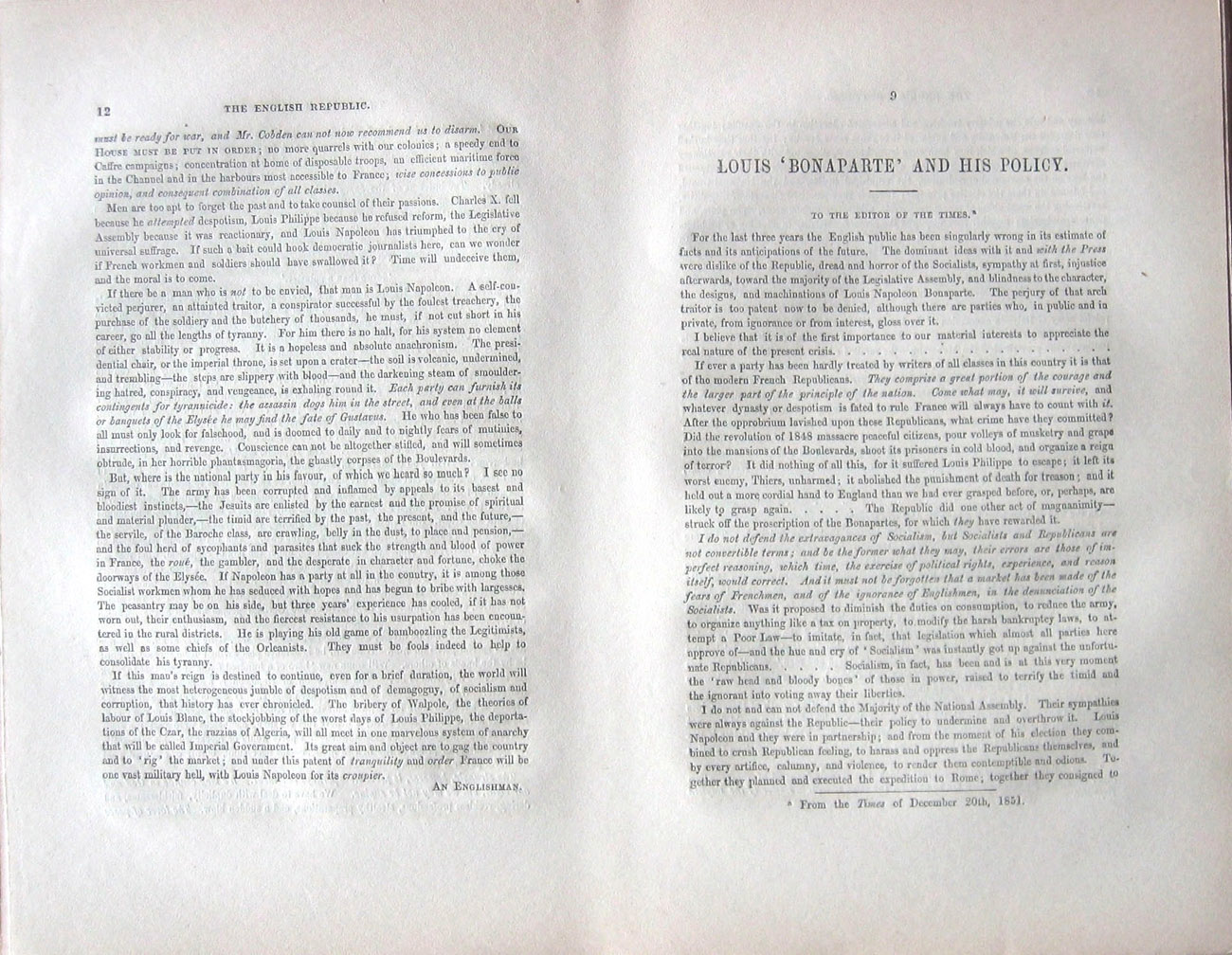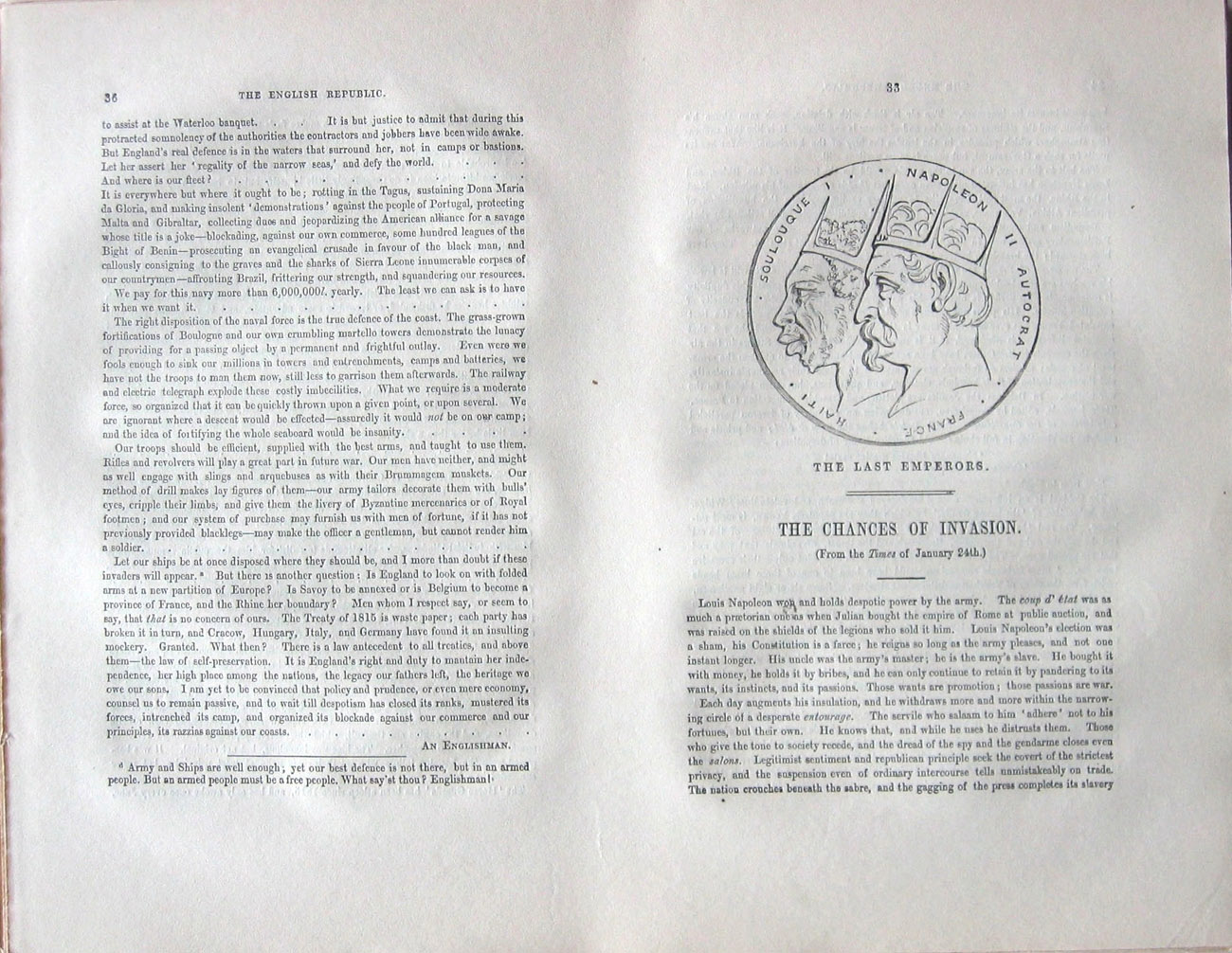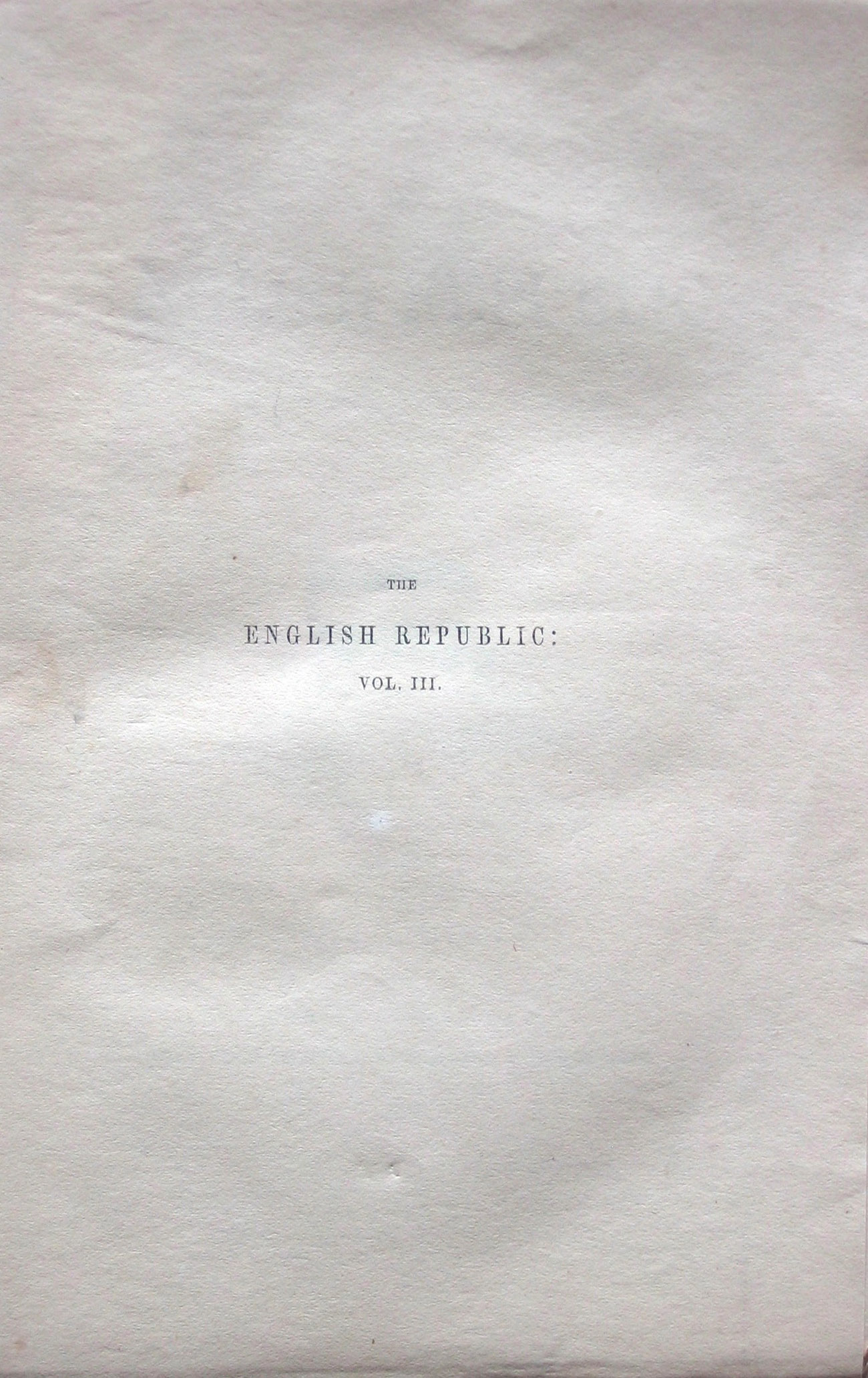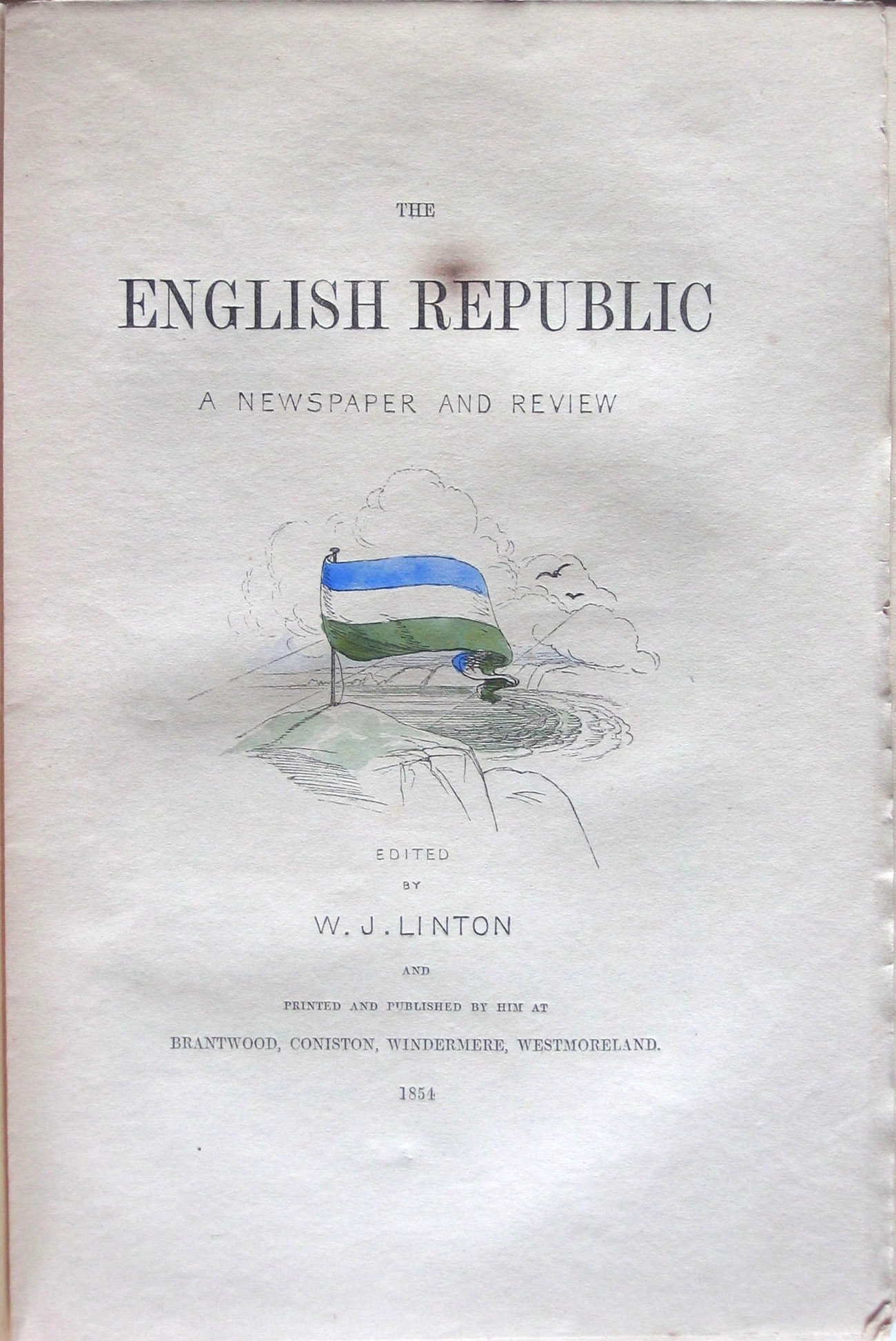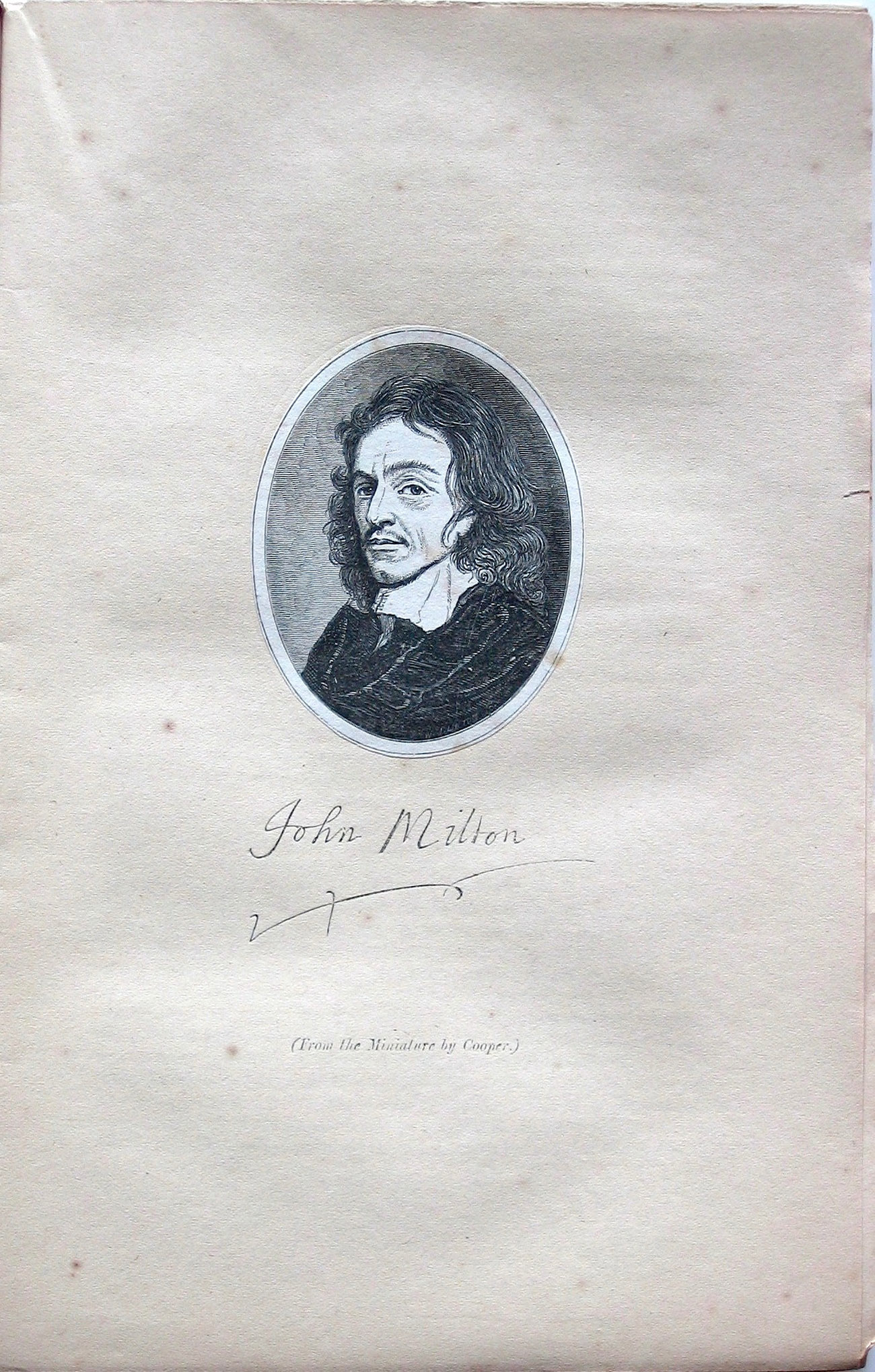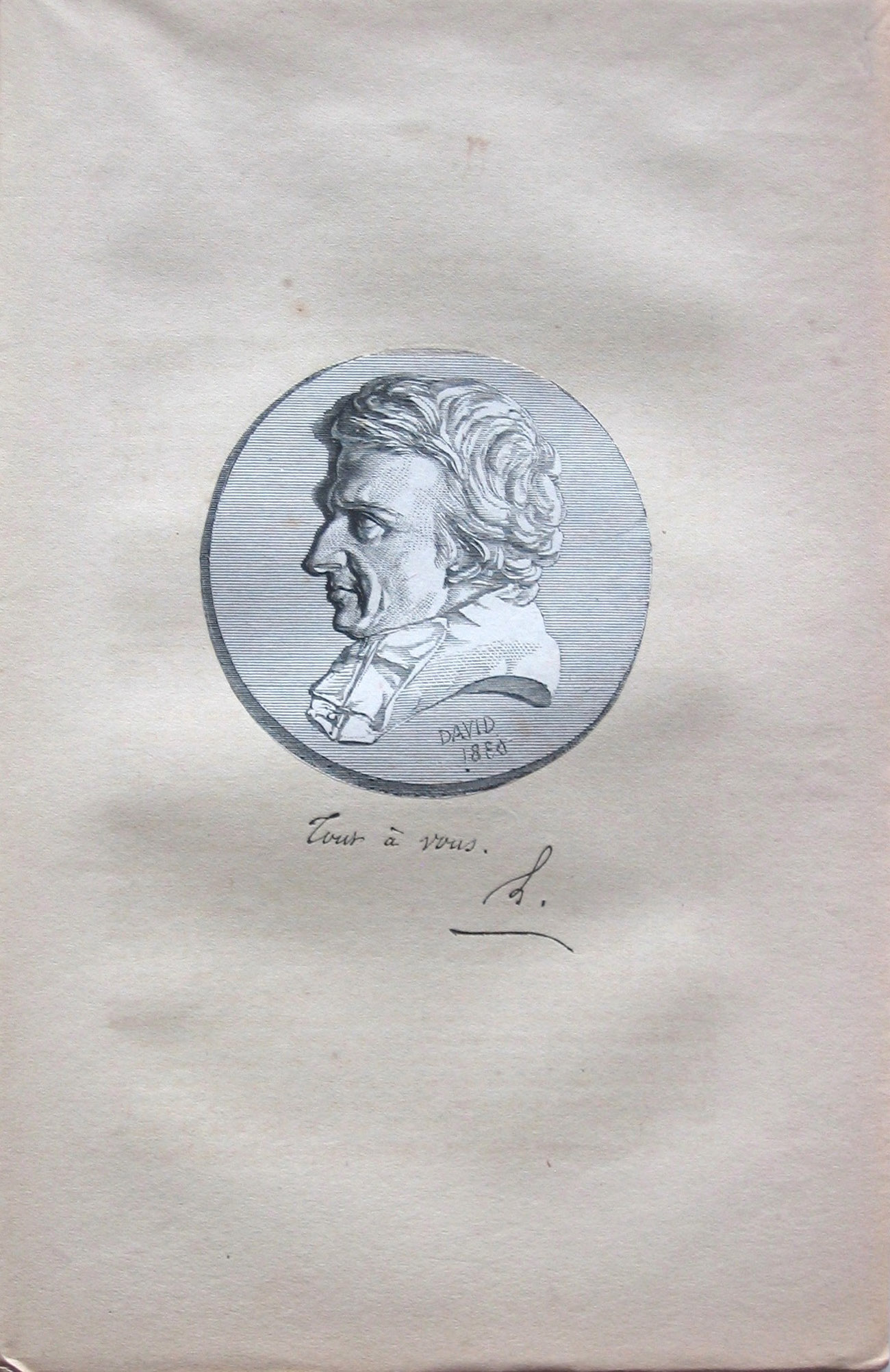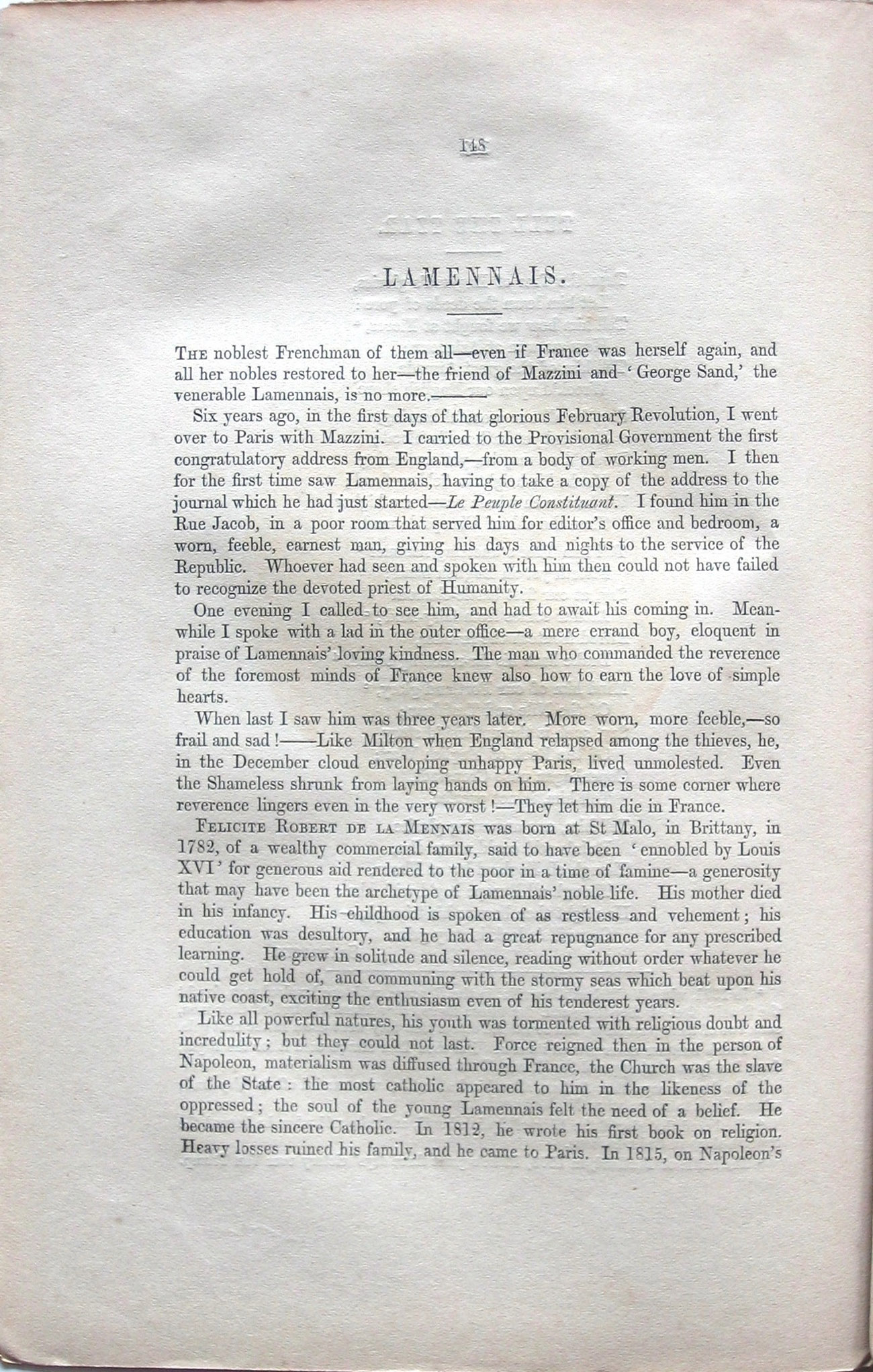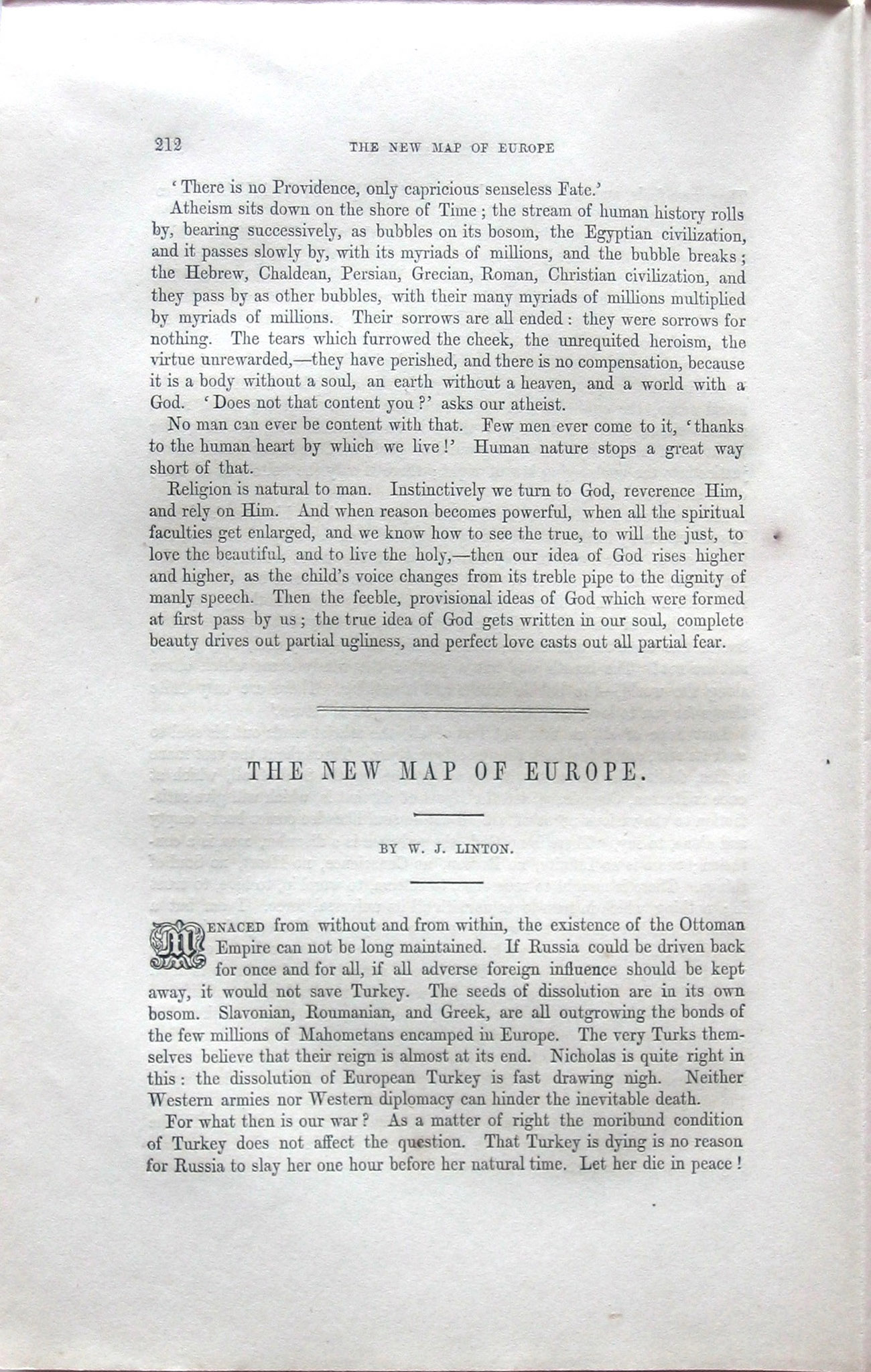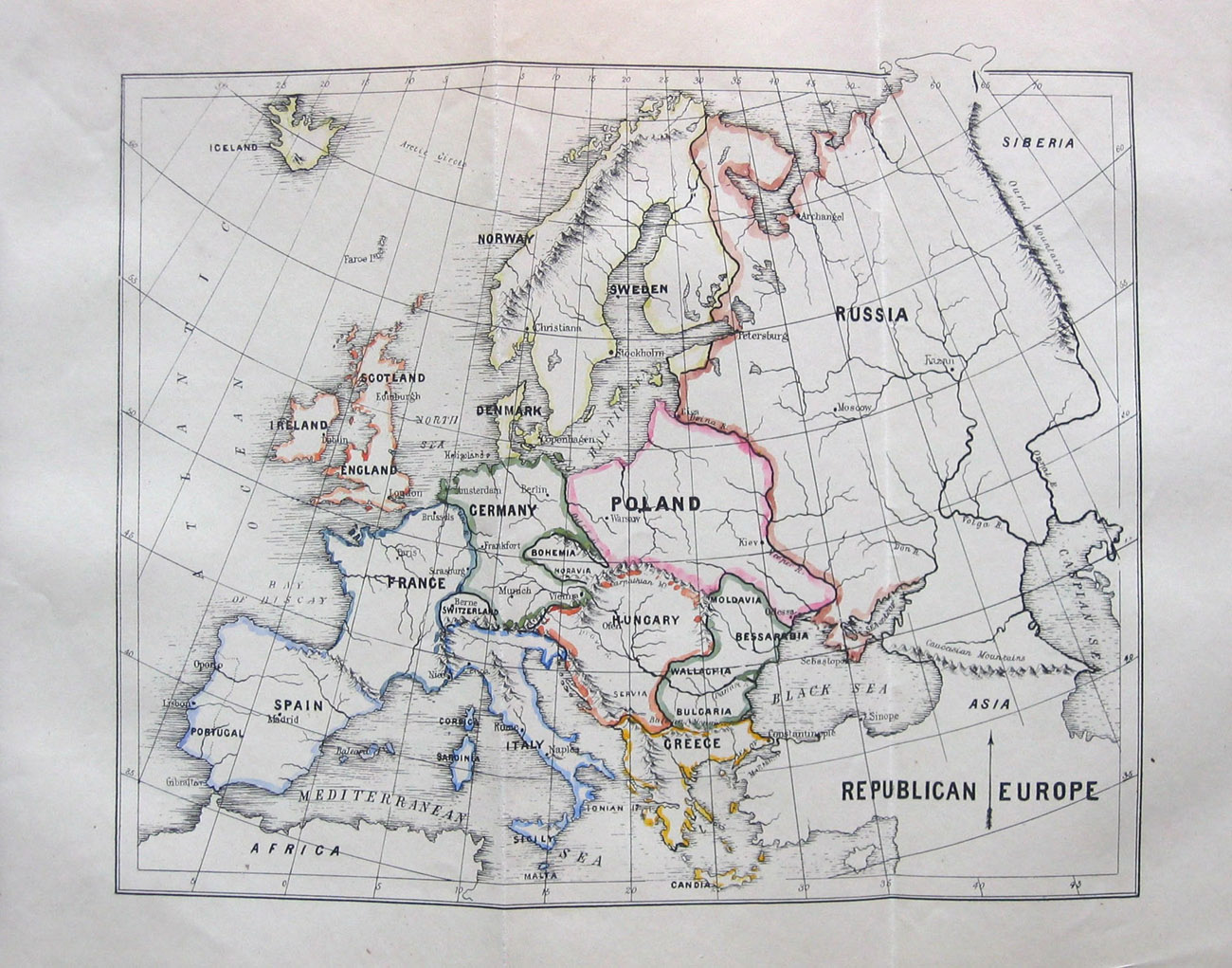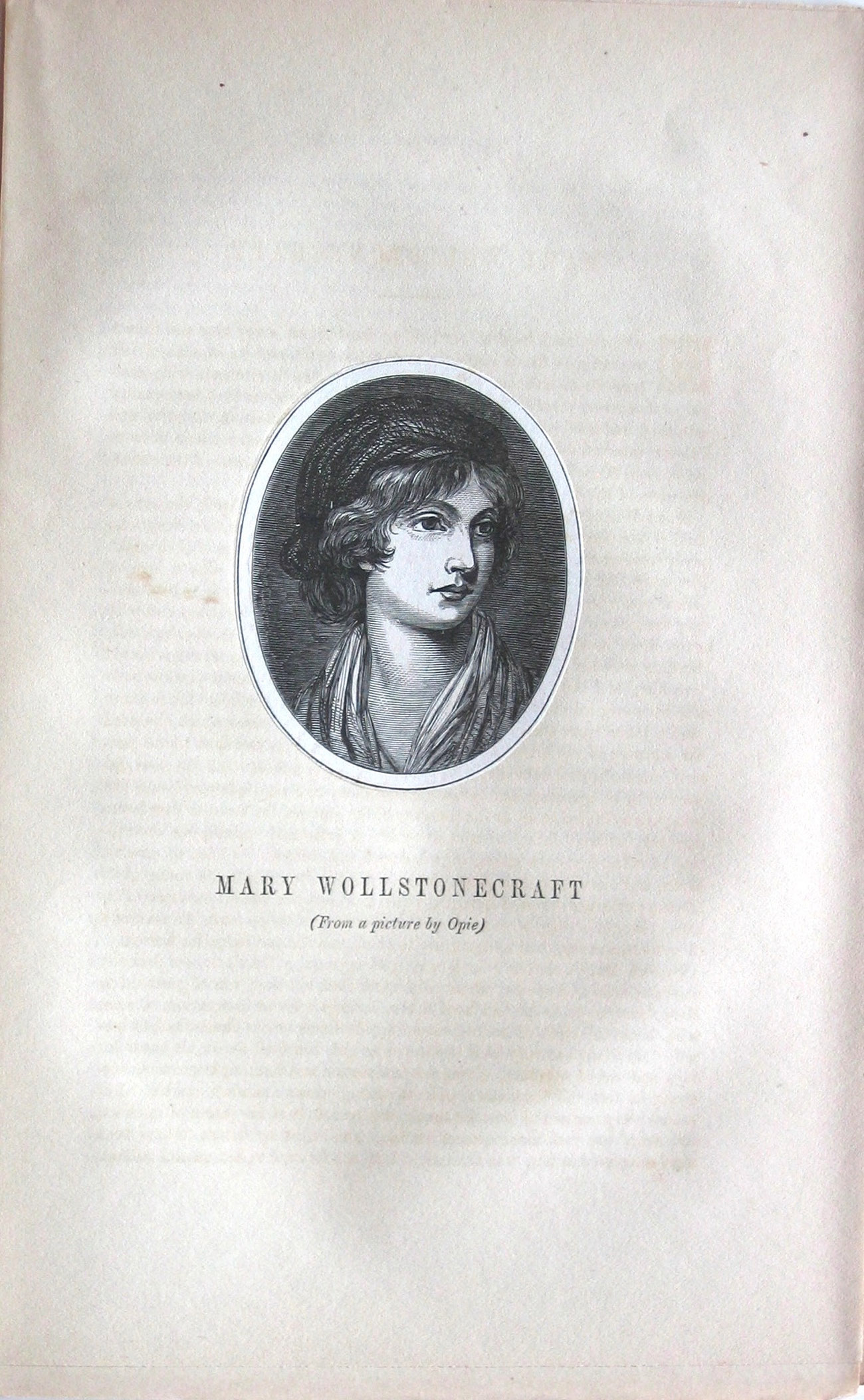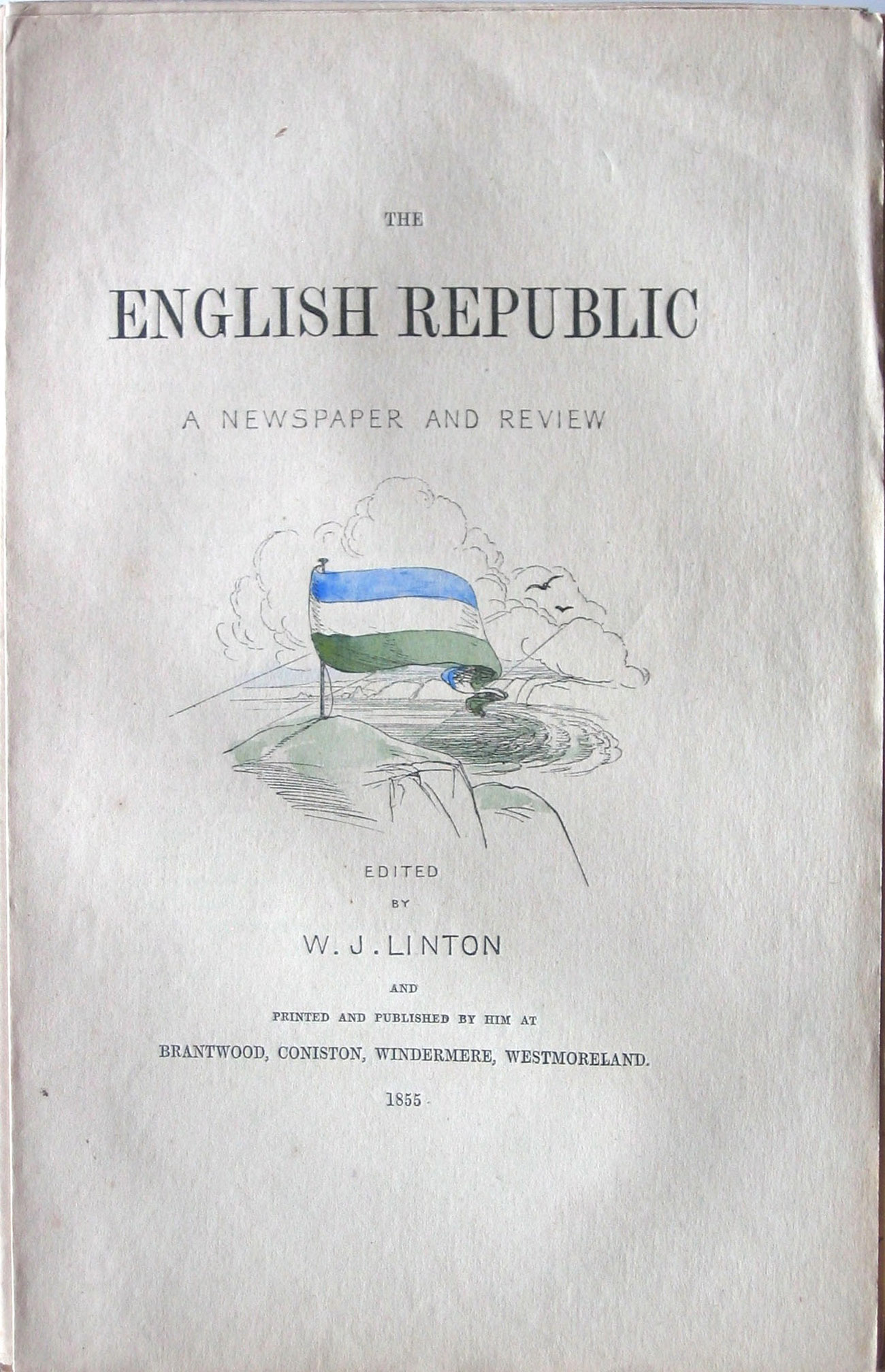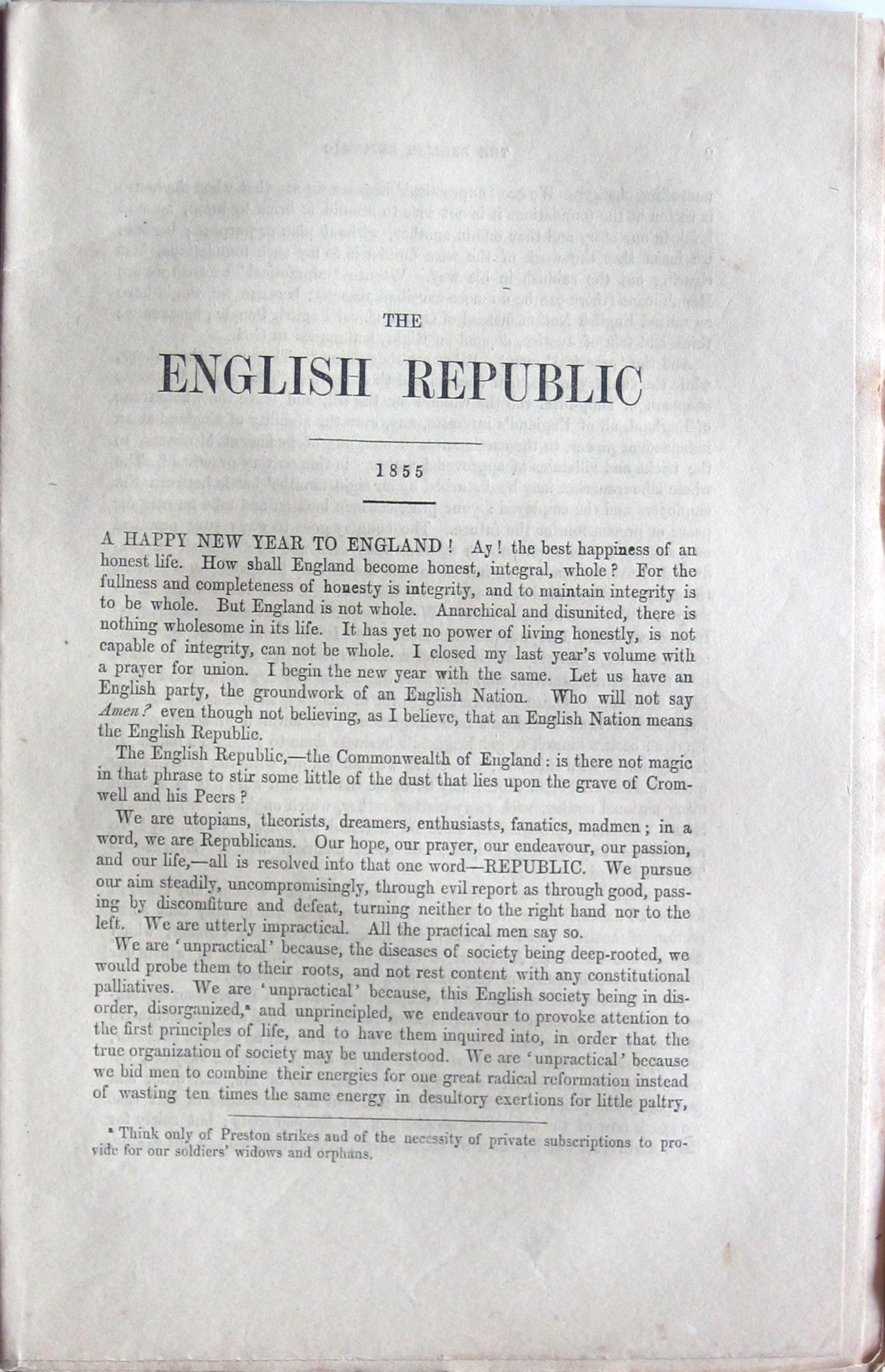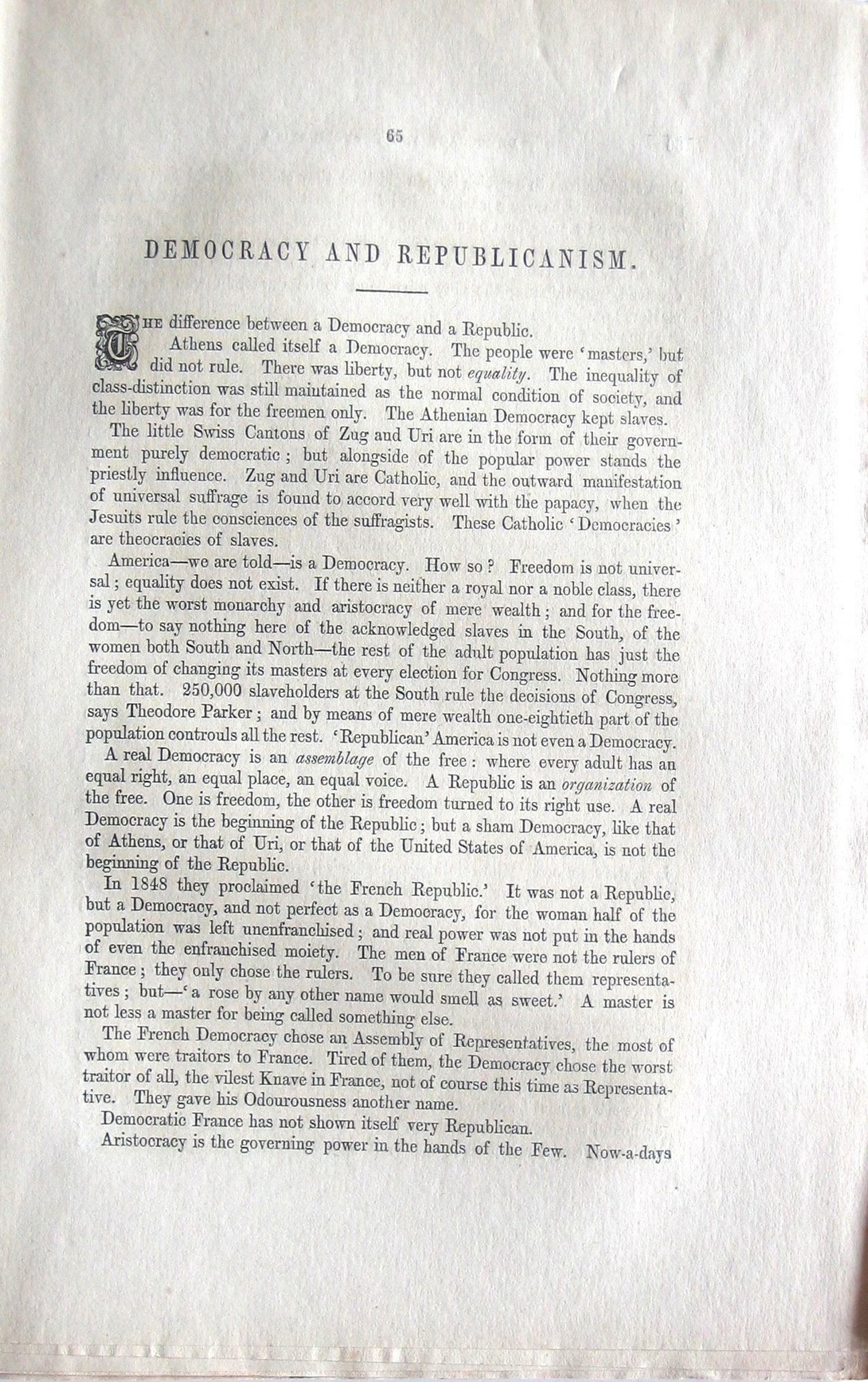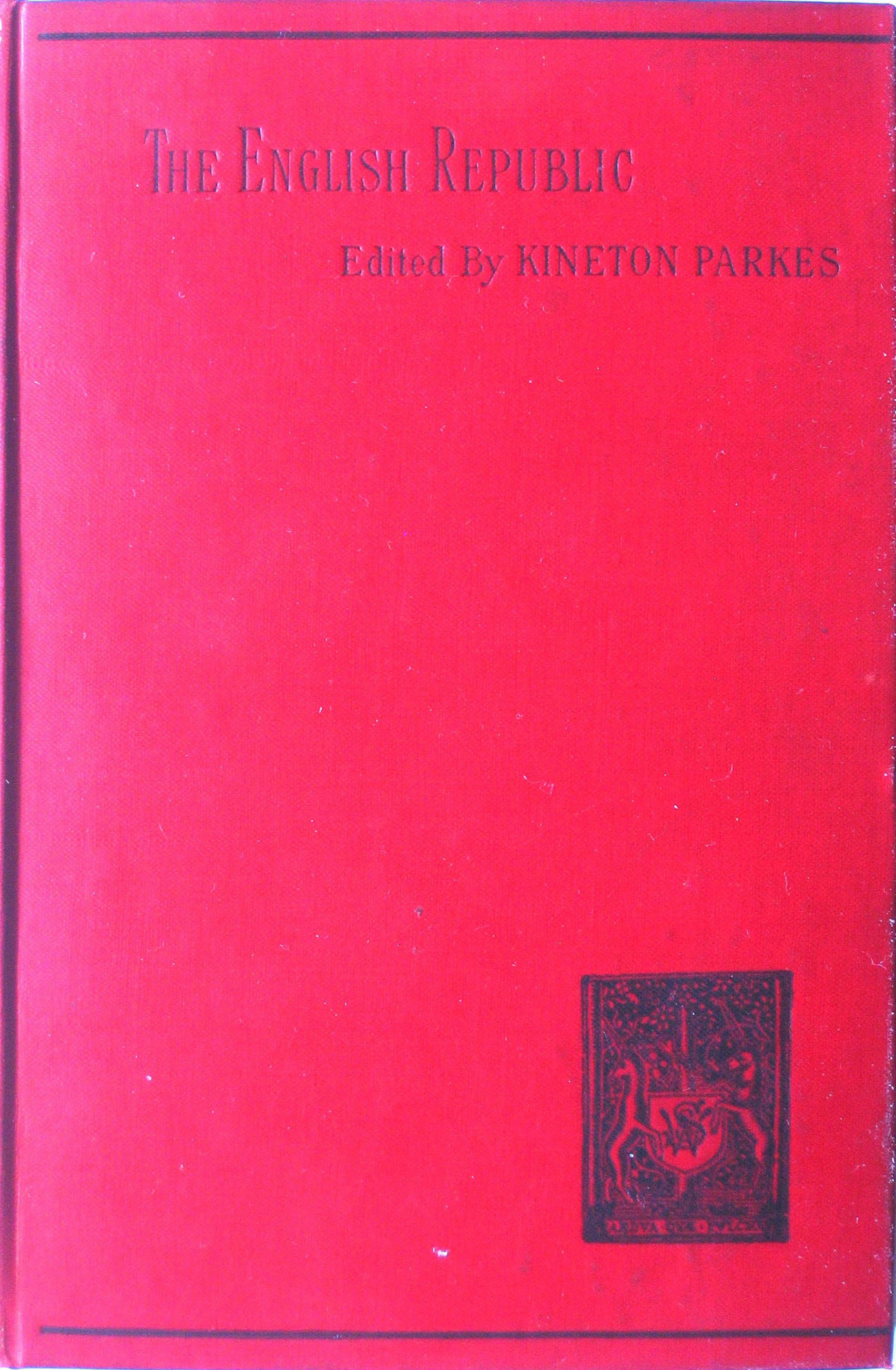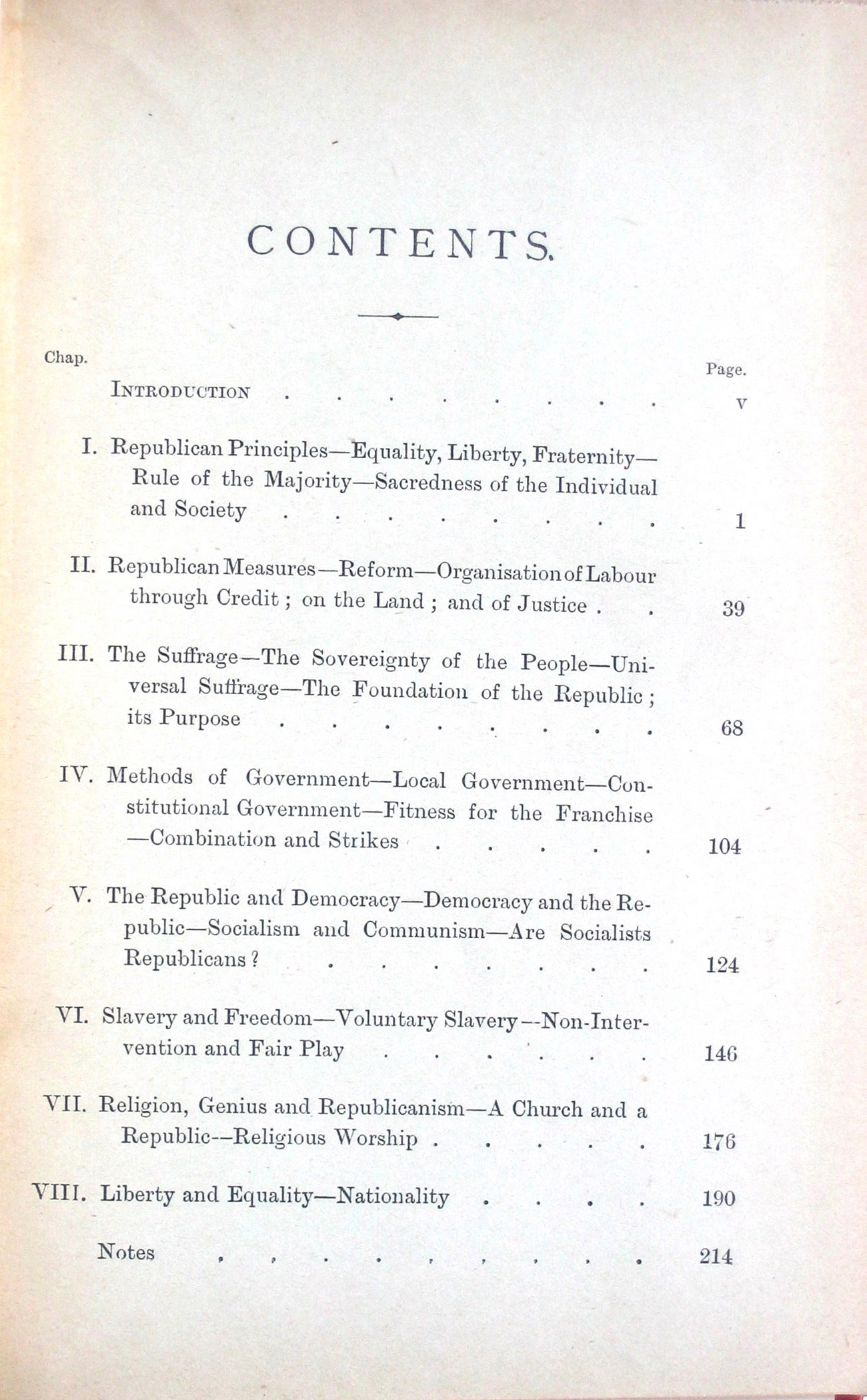Lintoniana I
“We are Utopians, theorists, dreamers, enthusiasts, fanatics, madmen, in a word, we are republicans.” W.J. Linton, 1850
In December 1850, almost two years after the revolutionary hopes of a democratic change had been buried Europe-wide under a mantle of resignation and depression, radical artisan William James Linton began to proclaim his forceful vision of an English Republic. In his characteristic overheated diction he exhorted his fellow countrymen to renew the ancient republican ideals of the English Revolution by establishing a strong national party which would be able to put the basic republican principles into practice: Liberty, Equality and Fraternity. In the following five years, he would amplify and equip his vision of a direct democracy in a flood of articles that poured out of his pen into his newly founded organ of propagandism.
The English Republic was issued at first in the form of weekly tracts and later continued as a monthly. Most of its parts were edited and printed in Brantwood / Cumbria. in the Lake District, where Linton had rented a ramshackle country house and set up his first private press. Only very few of the 300 copies of each issue of this unique quixotic project were ever sold in the bookshop of his friend and publisher James Watson. The rest was given away, mainly shipped abroad to his circle of radical friends.
One shouldn’t let oneself be blinded by the title of the journal and its jingoistic announcement: Linton’s vision of republic was in no account an isolated nationalistic one. He was a follower of Guiseppe Mazzini’s ideal of a European union of democratic republics, and the core of his journal is a map of a projected Republican Europe, which resets all the arrangements of the Restoration. From the very beginning of his career as a radical activist, Linton was concerned with building up an international network. Throughout 1851 he was busy organizing relief and employment for a large number of republican refugees who came from all over Europe. Beside his main hero Mazzini, some of the most prominent ideologists of the revolutions of ‘48 belonged to his friends and a few contributed to the journal: Alexander Herzen, the Russian philosopher, wrote on Russian Socialism and on his friend Bakounin, Karl Stolzman, the emigrant from Warzaw on the Polish fight for liberty and Wendell Philipps from Boston on American abolitionism. Linton’s friend Walter Savage Landor contributed some poems. There were also translations of the “Chatiments” of Victor Hugo, executed by the editor himself, and excerpts of pamphlets of Milton, of Lamennais and Ledru-Rollin. For Francis B. Smith, The English Republic represents “the fullest and most venturesome transposition of European republicanism into English.” 1
The nearly one thousand pages in close type comprise an outline of a new society which consists of four interacting circles of community: the family, the local parish, the republic nation and the world federation of national republics. The system is based on the principles of the inviolability of personal property, the participation of all people in the government, and on compulsory education, which is free of denominational control and to be provided in state schools and in trade workshops and model farms, which are attached to the schools. Linton’s call for the nationalization of land owes a lot the early agrarian communism of the Levellers and of Thomas Spence.
One of the central postulations of the English Republic is the national regulation of the economy. Linton posits his definition of liberty as “the growth of all” against the idea of the liberty of free trade “ – the liberty which is not regulated (..) every man’s hand against every man, and the weakest going to the wall.” The eighteen-fifties saw a generation of almost uninterrupted economic expansion in England with free trade as its gospel that gave Chartism, which once had been the forerunner of all organized labour movements, its deathblow.
Seventy years before the plan of a Social Credit reform was worked out by Major C.H.Douglas , Linton advocated a nationalization of the banking system: “It is one Business of the Government to be the nation’s banker, to furnish each individual with the material means, the capital for work, at all times and under all circumstances; else one’s right to property as the fruit of one’s work is a mere mockery.”
In his biography, author T.B. Smith stated in 1973 that Linton’s vision of republic, this unique blend of radical idealism and political pragmatism, “remains an open programme to be worked for rather than an obsessively detailed final plan. It is still a creative, stimulating project when most other utopias are dead.” 2
After five years of incessant effort, Linton finally gave up in April 1855 due to the lack of sufficient support, in financial as well as in ideal respect. He bid farewell to his audience by introducing himself for the first time as an artist, a poor one, “having to support a family and his daily earnings.” “I have written enough,” he concluded. “The time of words has passed, the time for action is come.” The action that would follow, the Paris Commune, in which some of his friends were involved, ran a chaotic and bloody course and decried all egalitarian ventures for decades.
In commercial respect, the project was only one more failure in a long list of debacles. It reached a wider audience only thirty years later in a popular compilation by Kineton Parkes, in a time when the Socialist International had already been founded and radical utopianism had become an essential element of the Aesthetic Movement. Kineton Parkes, the young co-editor of the Journal of the Ruskin-Society could easily recognize the significance of the work of the old Chartist and its function as a blueprint for the socialistic schemes of his mentor Ruskin and of William Morris, who was decisively inspired by him. But far beyond its intrinsic force, the English Republic played an important role as a transmitter in the history of British radicalism because “it supplied a social democratic programme, a focus for egalitarian fervour… that kept alive the ‘moral force’ Chartist ideology through the period of Chartist demoralization.” 3
Kineton Parkes’ abridged version gives only a weak impression of the original mixture of poetry, news, political tracts and agitated pamphleteering, which was edited by Linton in the bricolage tradition of radical journals. Especially noteable is his abstinence in matters of illustration.
This is the all the more surprising as he was known in radical circles as the artist of the “Cause”, who contributed with his drawings and lettering to a lot of journals. The masthead of the Red Republican (1850), which he designed, and the illustrations, which he made for his first journal The National (1839), were completely outstanding in their expressiveness. In the English Republic, the main intention of which was to mobilize the old virtues of the Puritan revolution, he preferred a very different graphic concept of stringent relevance and purity. He tolerated only very few images, and these rare ones had to serve the “Cause” in a pointed way: The colours of the illuminated republican flag, which crowned the front pages, were of such symbolic significance that it subsequently became the emblem of the National Republican Conference of 1872; the illuminated map of Republican Europe was printed as a foldout, so it could be pinned to the wall for demonstration purposes; a small number of heroic portraits of major exponents of the English Revolution is contrasted with caricatures of the villains of Restoration and Imperialism to point out the crucial difference.
W.J.Linton, The National (1839)
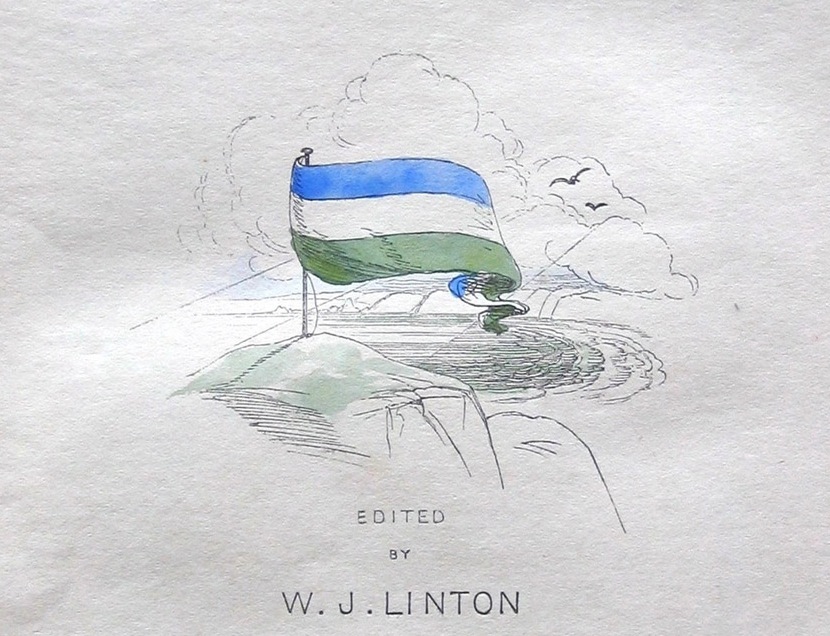
W.J. Linton, The English Republic (1851-55)
In conceptual respect, Linton’s editorial project stands in one line with William Blake’s “Continental Prophesies” as a comprehensive vision of a democratic regeneration of the continents under the ideological guidance of Albion / England and with Joseph Beuys’ “Bureau for Direct Democracy”, which resulted from the idea of political commitment as an expanded form of art. In its mere consistency, Linton’s enterprise is even more disturbing than both of them, and far beyond the arty efforts of his Arts & Crafts followers.
Complete sets of the English Republic have always been very rare. In his foreword to the edition of 1891, Kineton Parkes declares that he wasn’t able “to obtain a copy for the purposes of this edition in spite of much advertising”. The set of all four volumes, which is kept in the MePri- Collections, seems to be the only existing one with all four hand-coloured cover pages. This version, which has been preserved in an unbound and uncut state, was Linton’s private copy. He took it with him when he emigrated to America in 1867 and kept it in his desk in his home in Hamden /Connecticut, where he died in 1897.
Digital versions of two parts of the English Republic exist:
The Univeristy of Michigan provides a version of Part I, London 1851
and the Bodleian Library, Oxford a version of Part III, Brantwood 1854
The Kineton Parkes edition is reprinted by Kessinger Pub.
Annotations:
1) T.B. Smith: W.J. Linton. Radical Artisan. Manchester, 1973 p.105
2) „ p. 105
3) „ p. 107
